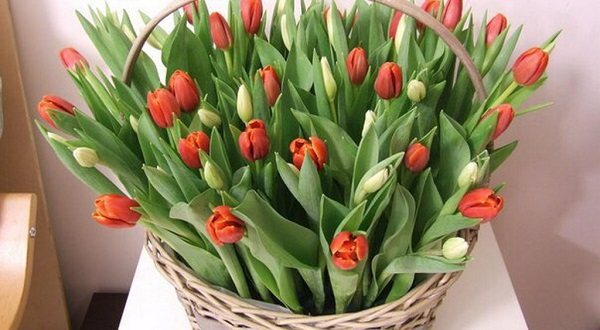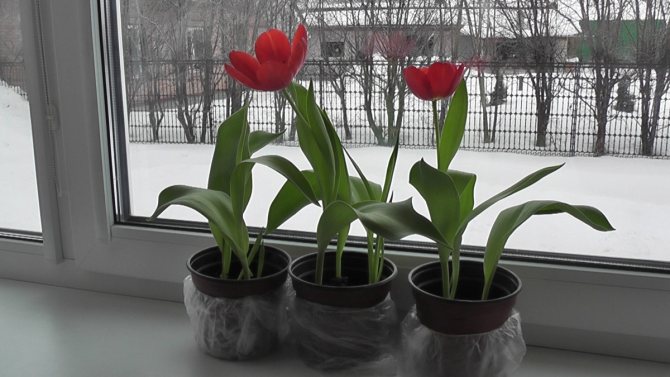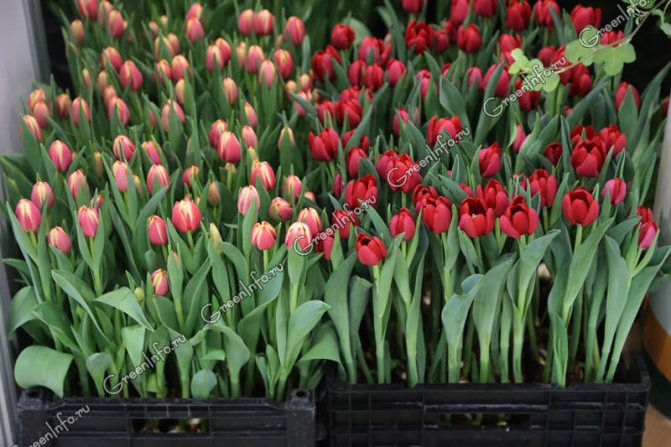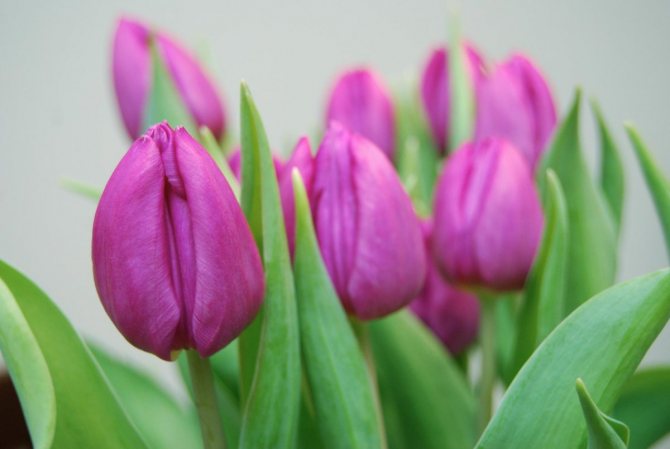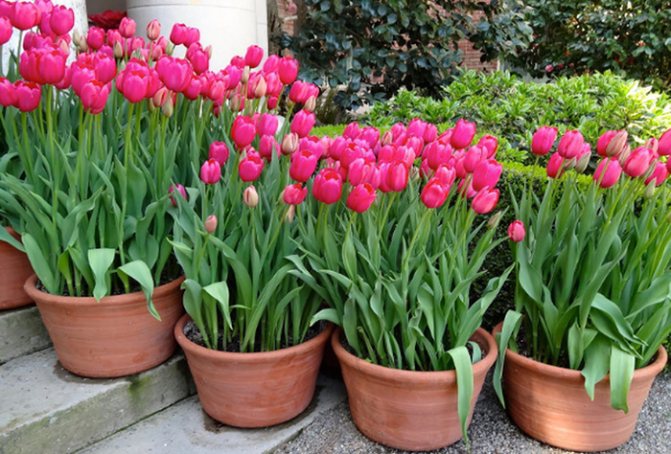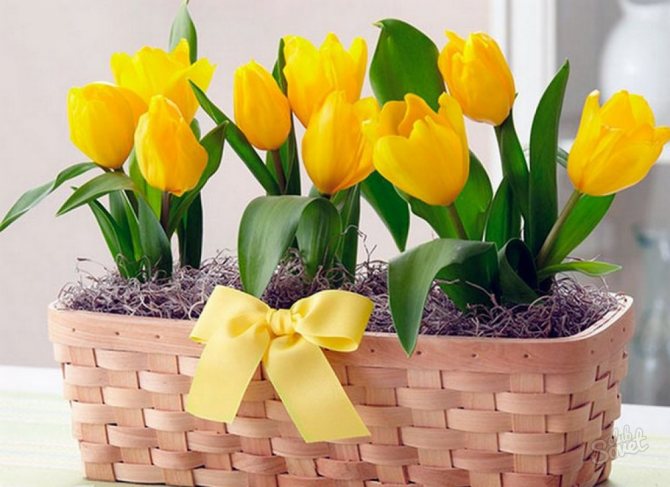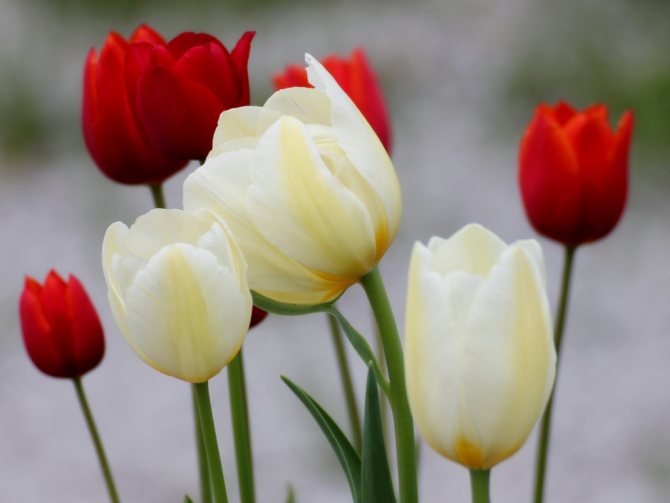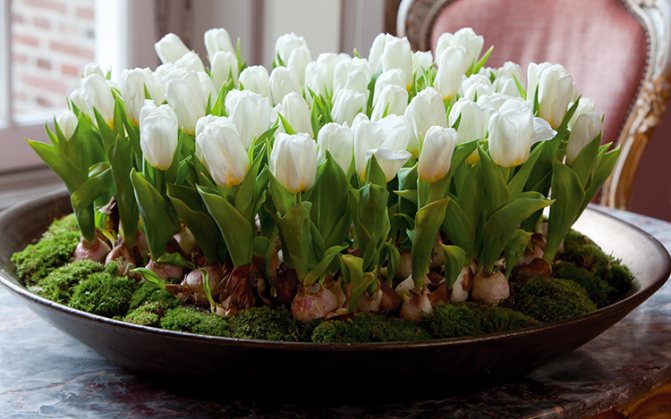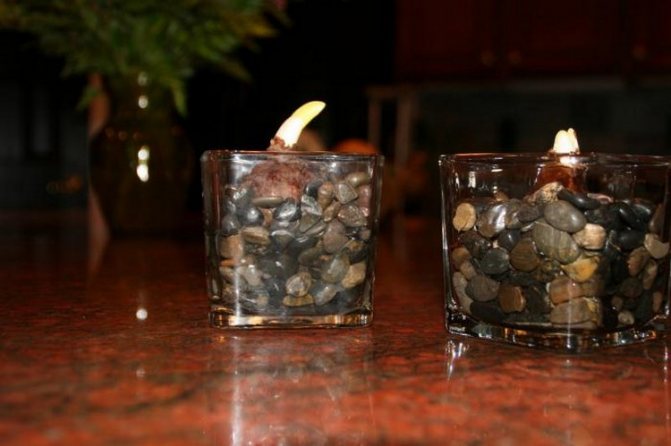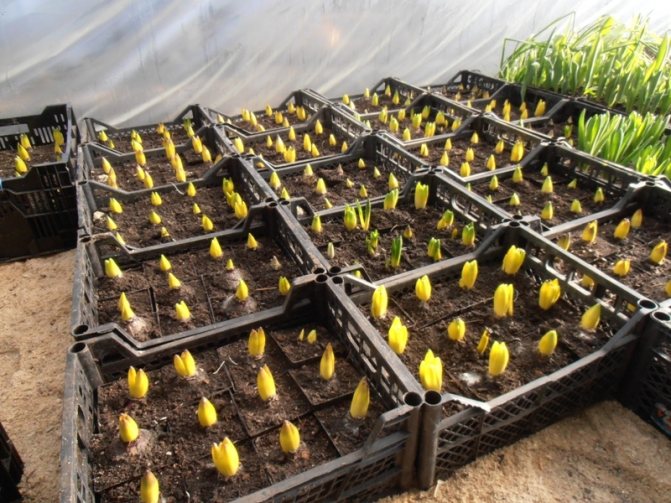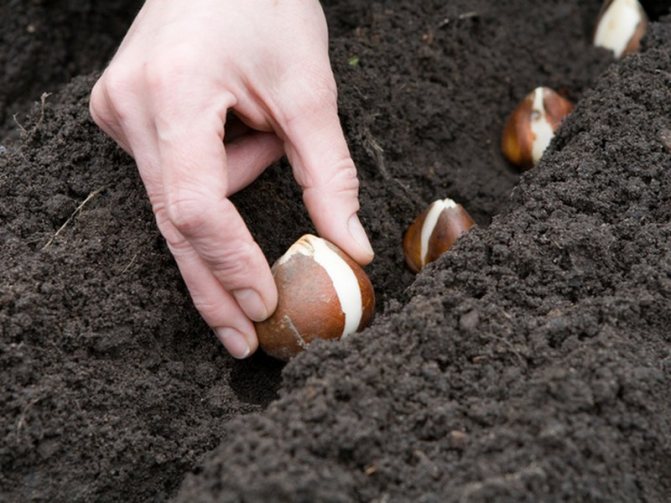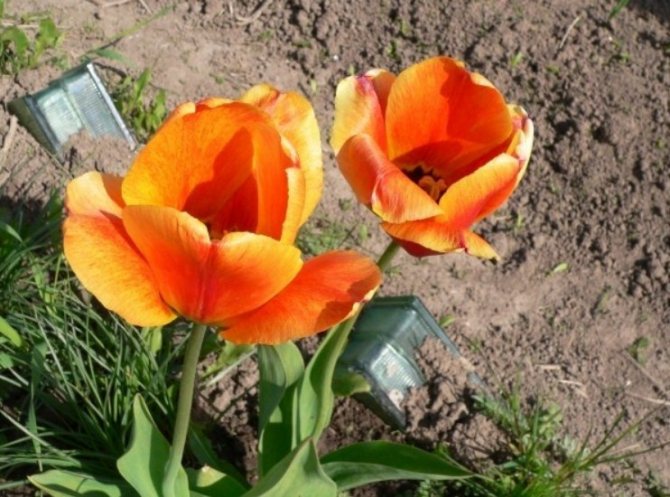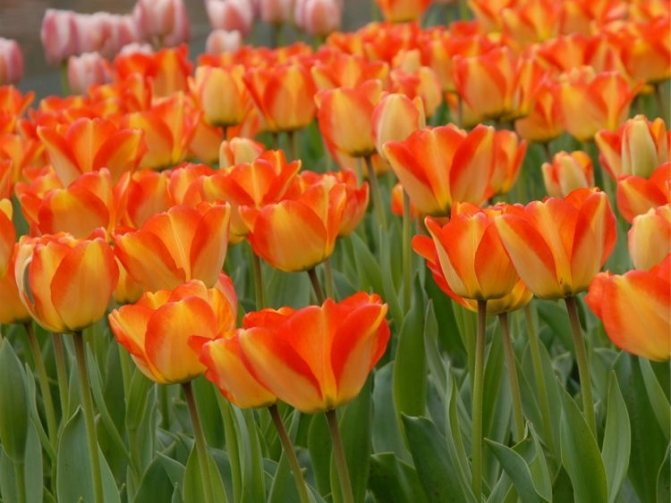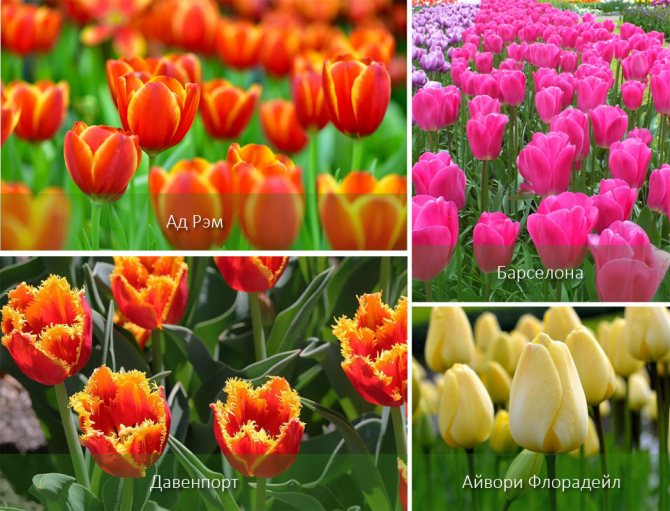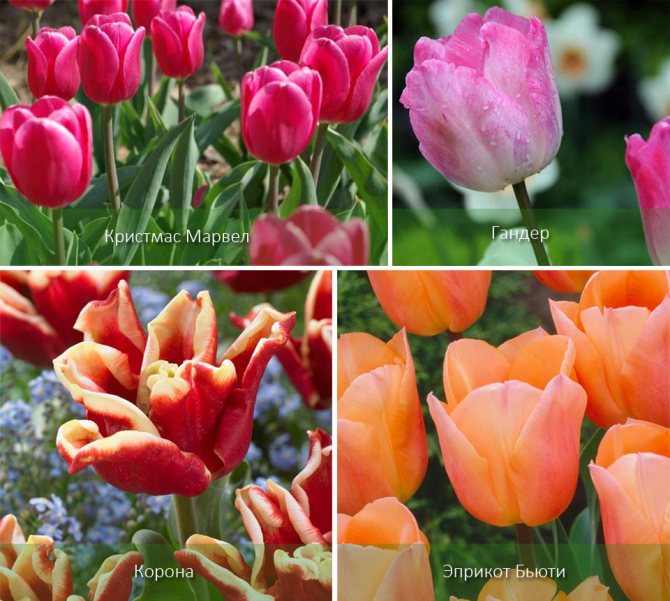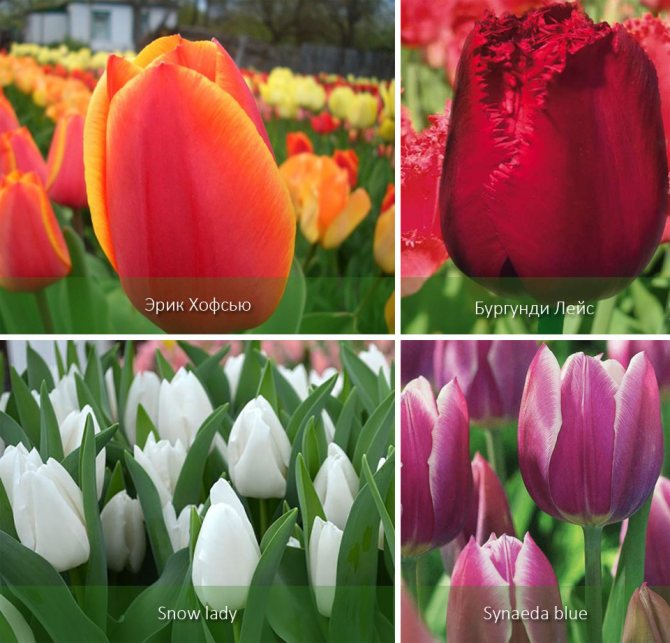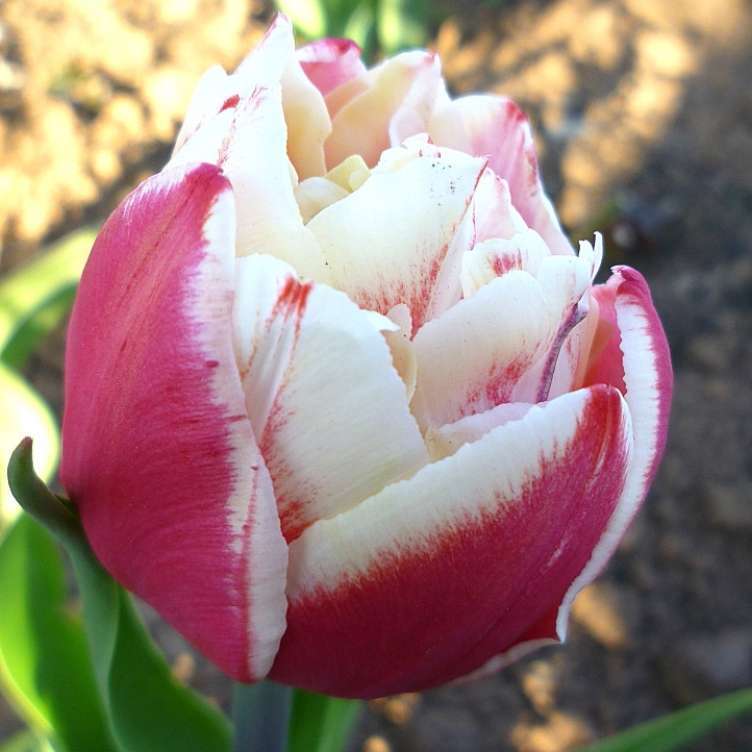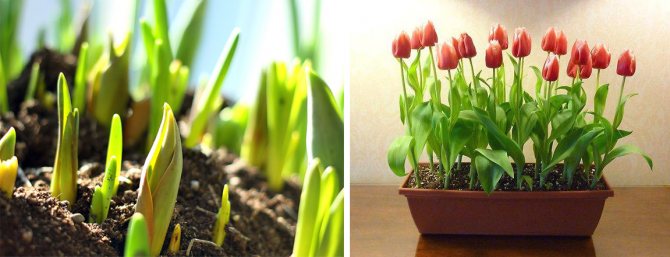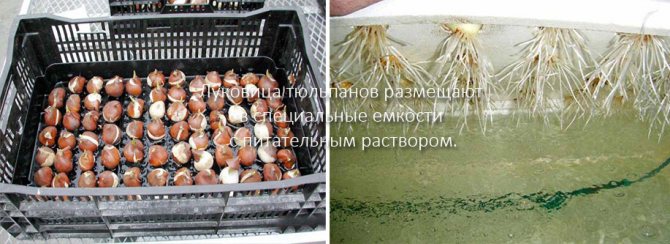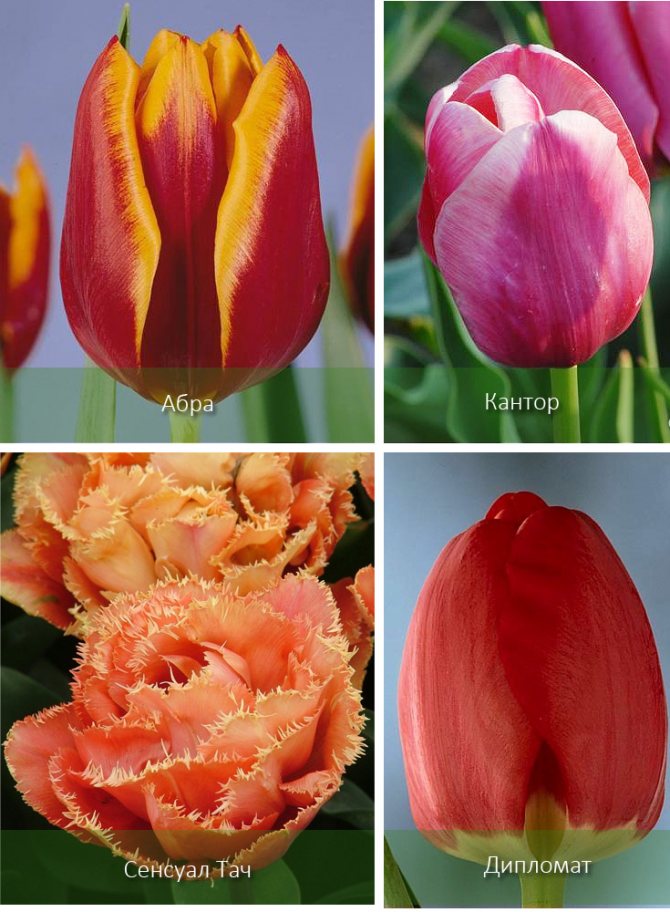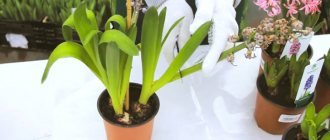The most famous bulbous ornamental plants are tulips. They are associated with the first warm days of spring. Numerous varieties of these beautiful and unpretentious flowers, which have various colors, shapes, sizes, adorn garden plots from early spring to summer.
But such beauty can be admired almost every season, growing these flowers at home using forcing. Tulips are among the best forcing ornamental plants.
What is plant distillation
Forcing are measures aimed at ensuring that the plant blooms much earlier than the due date for it.
In temperate latitudes, plants are dormant in winter in order to winter normally and gain strength for the new season. Although outwardly it looks like they are practically frozen, in fact, complex processes are going on in the tulip cells that will affect the quality of the future plant.
Using a specific forcing technology, the bulbs can come out of dormancy much earlier and flower. All this takes place under the influence of certain temperatures and humidity levels. The most relevant early distillation of tulips to get cut tulips by March 8, New Year, Valentine's Day.
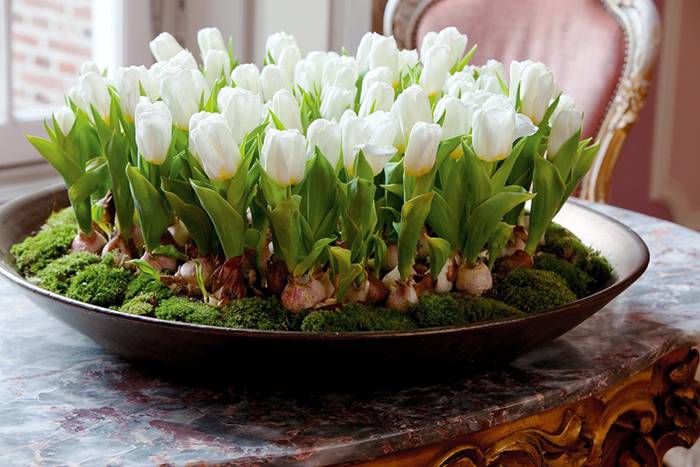
In natural conditions, the cooling period in winter is considered a mandatory factor of influence. Therefore, tulips for distillation must also go through this stage. Depending on which variety will be grown, exposure to low temperatures on the bulbs is required for 17-22 weeks.
Storage and growing of bulbs after distillation
Some growers believe that these bulbs are no longer suitable. But this only applies to those tulips that were grown hydroponically (in water).
In other cases, you can restore them using one of the growing methods:
- In low-growing varieties, after cutting the flowers, the leaves are also cut off. The bulbs are kept in the ground for 3 weeks and then dug out.
- In varieties with long peduncles, the leaves are left and continue to care for the plants until they are completely yellow. And then the tops are cut off and the bulbs are dug up. In this way, sufficiently large specimens are obtained, and children also grow up.
After they are dried for 2 weeks in a warm place, and then stored in cool conditions until the next planting in the ground.
It is impractical to keep the bulbs after forcing early. In order for such plants to bloom again, they will need to be grown for more than one year, so that they are strong enough for flowering.
Tulip varieties for forcing at home
In order to get healthy flowers on time, you need to have high-quality planting material corresponding to the forcing time. Also, when buying bulbs, a florist should take into account such factors as: decorativeness of flowers (shape, shade), biological characteristics of the variety, how long the buds will last after cutting.
Be sure to take into account the ripening time. Early tulips will be grown in the New Year area, medium early - January - February, medium - late winter - early March. Flowers from late varieties can be admired in April-May.
For forcing early varieties, the best option would be to buy bulbs that have a cooling period of at least 2.5 months. These are simple varieties of tulips, flower diameter - up to 8 cm, plant height - up to 38 cm. There may be such varieties: Suga Prince, Eprikot Beauty, Lustige Vitve, Brilliant Star, Purple Prince, Christmas Mervel.
For mid-early varieties (February 14), the cooling time should be slightly shorter than for early varieties. The flowers are large - up to 10 cm. The stem height - up to 80 cm. Varieties: Salmon Impression, Davenport, Fantasy Lady, Prince Gold, Pritty Wumen, Oxford, Eric Hofsue, London.
For late forcing (March and later), varieties of class 5 will be relevant. Their leaves have a blunt bowl-shaped shape. More than a dozen types of color shades: from white to dark purple. Ideal tulip varieties for distillation by March 8: Prana Violet, Versace, Hibernia, Sensual Touch, Triple A, Esprit, America, Burgundy Lace.
How to preserve cut tulips after forcing
In order for cut tulips grown by forcing to stand longer in a vase, use cool water in which tulips are kept throughout the day. With cold water, you can extend the life of your flowers. Also remember to change the water once a day.
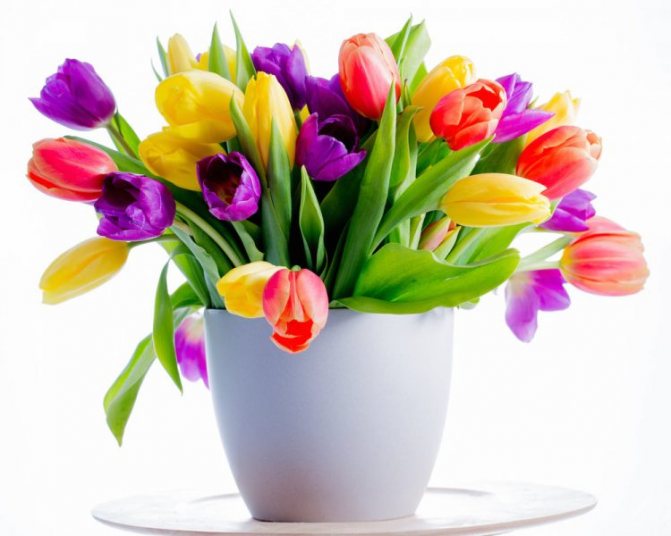

So we talked about the main points of distilling tulips for the winter and spring holidays. We hope our article will help you deal with this process, and you can please those around you with your beautiful tulips.
loading ...
The sequential process of forcing tulips at home
How well and timely tulips will bloom will be influenced by several criteria: correct planting in the soil and care, cutting and storage of buds.
The step-by-step forcing of tulips at home begins at the stage of harvesting the bulbs and their maintenance (if they have been used since last year, and new ones are not bought). The bud has opened up - after 4 days it is better to cut the flower, so that all the nutrients go to the laying of the bulb - high-quality planting material, and not to the formation of the seed box.
The bulb itself is dug up a couple of weeks after the leaves have begun to turn yellow. It should dry well in a ventilated room or in the shade. After that, sort out the planting material: discard, mechanically damaged bulbs or fungal diseases. Healthy specimens weighing at least 25 grams should remain.
To identify in advance the foci of fusarium and give a faster impetus to rooting, it is better to remove the scales before planting.
How to store tulip bulbs correctly
After the bulbs have dried, they are stored in plastic or cardboard boxes for storage. There must be holes in them so that the bulbs can "breathe". They are placed in a well-ventilated room with a temperature of + 22 ° C - this is how they are stored for 30-34 days. Over the next 2 months, lower the temperature to + 20 ° C and + 17 ° C, respectively.
Exposure at these temperatures is essential for normal flower formation, as these are typical climatic conditions for flower germination. It is important that the formation of the flower bud has already been completed before the start of the cooling period.
If it is required to distill tulips in the apartment in winter for the indicated holidays, then the holding periods at certain temperatures are shortened. In such cases, early digging of the bulb and storing it for at least a week at + 4 ° C can accelerate flower formation. The process of cooling the bulbs (if there are not many of them) at home can be carried out in the refrigerator on the lower shelf.
From mid-late October, they are planted in pots or special pots and taken out into a chilled room with a temperature of +3 - + 7 ° C. Approximately 1.5 months after planting, the rooting temperature is + 5 ° C. Such temperature conditions are important so that the sprouts are not very elongated. Tulip bulbs will take 16-22 weeks to root and germinate (depending on the species).
Terms of work
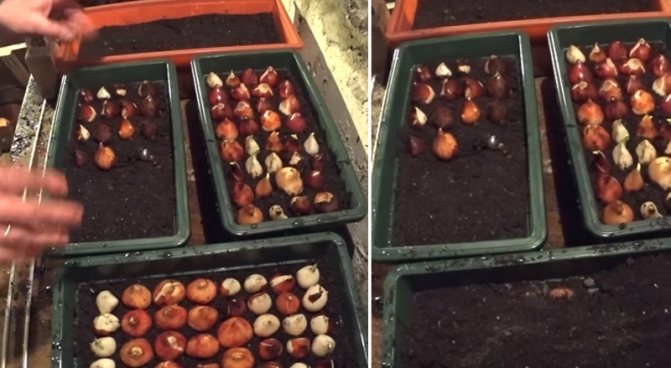

In order for the flowers to grow by the New Year, it is necessary to clearly choose the planting period, the tulips should have enough time for growth and development. It is impossible to delay this work, preparation and all planting activities will have to be done in the fall. Remember simple guidelines:
- Dig up the bulbs for drying no later than the end of June. If you miss the time, then they simply will not have time to ripen and form the rudiments of future stems and buds inside. The planting material needs a certain period of rest, it will not work to reduce it.
- Plant in mid to late September. The earliest ripening varieties can be placed in the soil in October, but it is better not to tighten it so that it does not happen that the buds begin to open in January.
- At the time of planting, the prepared bulbs must lie in the cold for at least 16 weeks, in some varieties the period is slightly less or more. You cannot get them ahead of schedule.
If the planting is carried out late, there is no guarantee that the flowers will grow for the new year. You can try to speed up the process by creating optimal conditions for development, but there is no guarantee that the tulips will bloom. Better to land a little earlier, it's not scary.
Methods for forcing tulip bulbs
Planting, conditions of care and cutting of flowers will depend on the method of forcing tulip bulbs at home: in soil or hydroponically (in water).
Germination in the substrate. To get healthy buds and use the bulbs for planting in the future, it is better to prepare a nutrient mixture. To do this, mix humus and sand, peat, soil (sod) in a ratio of 1: 1: 1: 2. A glass of ash is also added to the bucket of the finished mixture. It is allowed to add special fertilizers in the form of granules for flowering plants.
Alternatively, you can use the following soil composition: sand, earth with humus, turf soil. Those who add sawdust to the substrate make a mistake, because it has an acidic reaction, weakly retains moisture. You can also buy special soil at the flower shop.
Clay pots or wooden boxes are suitable as containers for home growing. If the potting mix is prepared at home, all components are thoroughly mixed. The mixture is poured 2/3 into the container and lightly pressed with the palm of your hand. The bulbs are pressed into the ground with light pressure (preferably with the flat side facing the side of the pot).
All bulbs must be approximately the same and must not be planted back to back. The rest of the soil is filled up and compacted so that the top is not completely covered. Freshly planted bulbs are watered with a weak solution of potassium permanganate. Further, watering is carried out weekly as the soil dries up.
Experienced flower growers argue that you need to have a special approach to watering. Humidity until mid-December (subject to planting in October) should be kept within 80%. Care must be taken to ensure that there is no moisture on the leaves or sprouts. Otherwise, this is the first step towards decay of the plant.
3-3.5 weeks before the preliminary flowering of tulips, the pots are brought into a warmer room with a temperature of +12 - + 14 ° C for 5 days. After that, the temperature is increased by another 4-5 degrees. If the buds have blossomed a couple of days earlier, it is better to put them in a room with a temperature of + 14 ° C. If the temperature is higher, the plant will stretch out quickly, the flowers will be weak.
Forcing tulips hydroponically. Good flowers at home for yourself or for sale can be obtained by forcing tulips in hydroponics. But it must be borne in mind that such bulbs will be unsuitable for growing. This method is recommended if there is no room at home for massive boxes and large pots.
For forcing on water, use plastic dishes or narrow glasses.At the bottom you need to lay plywood circles corresponding to the size of the container. When placing the onion in a glass, make sure that the water is just below the bottom.
Planting bulbs in this way is also necessary at the end of October. The container is located in a darkened room at a temperature of + 5 ° C. If there is no dark room, you can just make a shelter.
During the planting period, it is imperative to add water (the plywood rises at the same time). Make sure that there is always a layer of air between the bottom of the bulb and the water level. So that the water does not stagnate, the plant does not disappear, add a tablet of charcoal or activated carbon to the water.
As soon as tulip sprouts 10-12 cm long have appeared, the plant is brought into a bright room with a temperature of +13 - + 14 ° С. As with growing in soil, after 5 days the indoor temperature rises by another 4-5 degrees. If flowers are to be obtained in early March, then it is advisable to start distilling at the end of October.
In order for the flowers to have a marketable appearance for a long period, they are cut at the stage of closed buds, which are in a semi-colored state. Store in cold water (no more than + 5 ° C), the plants are placed very tightly to each other. Such conditions will keep the flowers in good condition after cutting for a week - an ideal option for growing tulips by March 8th. It can be stored without water, but only in the refrigerator, having put flowers in plastic or cardboard boxes in advance.
The plant itself (after cutting the flower) is watered 2 times less often until the leaves turn yellow and the bulbs are dug out.
Tulip forcing technology is not a simple science, especially for novice florists. But observing the conditions for planting, caring for and storing flowers will make it possible to enjoy the result of forcing, especially on Valentine's Day or March 8.
How to prepare containers and soil
In order to grow healthy plants in a short time, it is important to provide them with all the necessary substances. Each bulb needs a certain space, with a strong thickening of the tulips there may be little lighting, and they will grow much slower. Carry out the work in this order:
- Pick up containers for growing. These can be pots, boxes or containers for seedlings. The depth should be at least 10 cm to provide enough room for growth.
- Carry out disinfection of containers. Use a solution of potassium permanganate or any other composition. The spray can be simply applied to the surface. When using a special product, follow the instructions on the package, observe the dosage when preparing the solution.
- It is imperative to pour a drainage layer on the bottom, take small expanded clay or vermiculite for it. Distribute granules evenly, drainage thickness approx. 5 cm.
- Mix in equal proportions humus or rotted manure, garden soil (previously disinfected with potassium permanganate) and river sand. Fill the selected container by about ¾ of the volume, you do not need to fill it completely immediately. Leave part of the mixture in order to cover tulips after planting.
Advice! If you don't feel like preparing the soil, it's easier to buy a ready-made version at a gardening store. Choose a mixture for flower crops.
It is better to use plastic boxes or special containers for long-length seedlings for growing. It is convenient to move them from place to place, it is much easier to water. Even a plastic container for fruit is suitable, but in this case, close the walls with pieces of cardboard so that the earth does not spill out through the holes.
Another option for distillation is to use containers with water or stone filler. In this case, you do not need to prepare the soil, but you will have to select containers of such a size so that the lower part of the bulb is located above the water, if the root part is in the liquid, it will begin to rot. The second option is to fill the container with pebbles, pour water over the level and arrange the tulips without touching the surface.
It is important to monitor the liquid level so that it does not drop.Another important point is the addition of water-soluble fertilizers, the plants will receive all the substances and trace elements necessary for growth.
What is distillation
Outdoor plants do not bloom in our rooms in winter. However, we can deceive them, convince them that it is time to wake up and bloom, artificially creating the necessary temperature and light conditions. This technique is called forcing bulbous. The entire cycle of forcing can be roughly divided into three stages:
- storage of bulbs after digging from open ground;
- their rooting at low temperatures;
- growing flowers in a heated room until flowering.
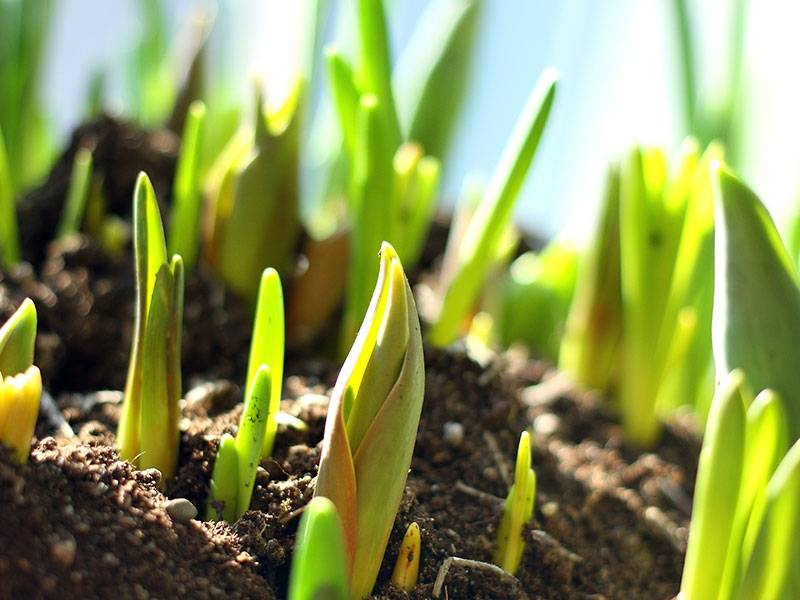

Tulips go through the entire cycle of their development before our eyes. Very exciting, but rather painstaking task. For some, it turns into a hobby. From year to year, amateur flower growers awaken thousands and millions of flowers to life.
Mr. Dachnik warns: mistakes made during forcing
The reasons for obtaining low-quality plants can be the wrong actions:
- Planting material is of poor quality or has not passed all the necessary preparatory steps.
- Sudden changes in temperature during growing and storage.
- Secondary use of soil in which putrefactive bacteria have appeared.
- Insufficient moisture or drying out of the soil during the cultivation period.
- Too long cooling time of the planting material or lack of it.
- Violation of ventilation in the room where the flowers were grown.
If you follow all the recommendations for forcing tulips, then you can avoid the appearance of defects.
The relevance of tulips to March 8
How to accelerate the growth of garden plants at home in order to have time to grow delicious flowers by the scheduled date, for example, by March 8? This allows for the winter forcing of tulips and other bulbous crops. Experienced gardeners know how to carry out a whole range of activities, awakening tulips to life in a period unusual for them.
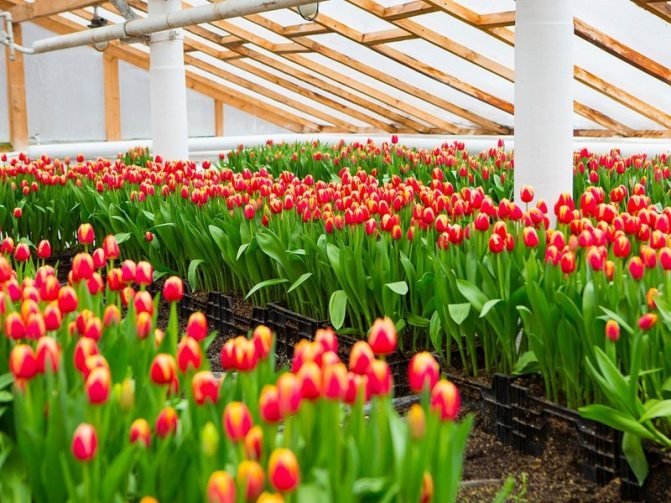

Tulips description
In European languages, the name of the tulip flower came from the Ottoman-Persian dictionary. The word "tülbend" meant the fabric for the national headdress. Later, this concept began to correspond not only to the material from which it was made, but also to the turban itself, which had an external resemblance to a flower. Probably, the borrowing took place almost simultaneously in the countries of Eastern and Western Europe, therefore the Italian "tulipano", the Polish "tulipan", as well as the German "tulpe" and the Dutch "tulp" that have lost the ending "an" have a common root. The word tulip entered the Russian language as a free reading of the Polish name of the plant.
Fresh articles for gardeners, gardeners and florists
Tomato seeds company Partner catalog tomato with description
Seeds of tomatoes of Siberian selection are the most productive
Tomato seeds are the most productive varieties for 2019 for the Moscow region
How to grow mushrooms at home oyster mushrooms
Tulips come from the lily family. In addition to them, this family includes: lilies, muscari, hyacinths, fritillaria, etc. A characteristic feature of these flowers is the presence of six petals (hybrid varieties have more petals) and six stamens with elongated anthers. Most often, one plant forms one bud; in some species, several buds are possible on the stem.
The shape of the petals is oval, semicircular, pointed with fringed or corrugated edges. The sizes of flowers can vary from small, only a few centimeters, to huge about 20 cm.
The color palette is very diverse, it includes all existing colors, tones and midtones. Thanks to the painstaking work of breeders, new types of tulips appear every year.
The stem of the flower is erect, cylindrical in shape.Its height depends on the type and variety of the flower 10-20 cm or 60-100 cm.
Tulips have leaf plates from 1-12 pieces, they are very important for the formation of the bulb next year. If they are lost during the growing season, the flower may die.
Tulips are bulbous flowers. The bulb is a bottom with scales, which are covered on top with protective scales that perform a protective function. The life cycle of the bulb is about 24 months, after which it dies off and forms daughter bulbs.
Basic rules for forcing tulips
For forcing tulips, processing times should be observed and quality material should be used. At the time of planting, the bulbs must have a weight of at least 25 g, having accumulated a sufficient amount of nutrients.
It is possible to calculate the timing of laying the bulbs if you accurately determine the periods of their planting and rooting.
The first period is keeping the plants in a cool place with a temperature of 5-8 degrees for 16-22 weeks, depending on the variety.
The second period is keeping the seedlings in a warm place with moderate lighting at a temperature of 12-15 degrees for three to four weeks.
Adding both periods together, we get the term for distillation of flowers. It remains only to set the date of planting the material.
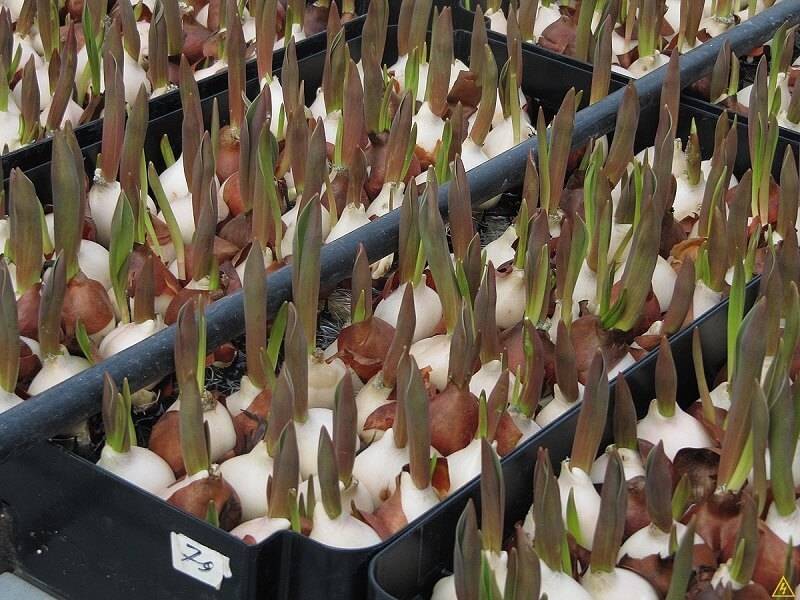

Tulips are planted at several times:
- early landing. Flowers will be ready at the end of December - early January (by the new year). The best varieties to be distilled this holiday season: Epricot Beauty, Dixis Favorite, Lustigue Battle, Miles Bridge, Diamond Star, Christmas Marvel;
- mid-early landing (for Christmas);
- medium landing (for Valentine's Day). For this period, the varieties Apeldoorn, Oxford, Confux, Scarborough are ideal;
- late landing (by March 8). By this day, varieties are usually grown: Parade, Keys Nelis, Eric Hofsier, London, Diplomat, Vivex.
You can plan the planting of bulbs for other significant dates and events.
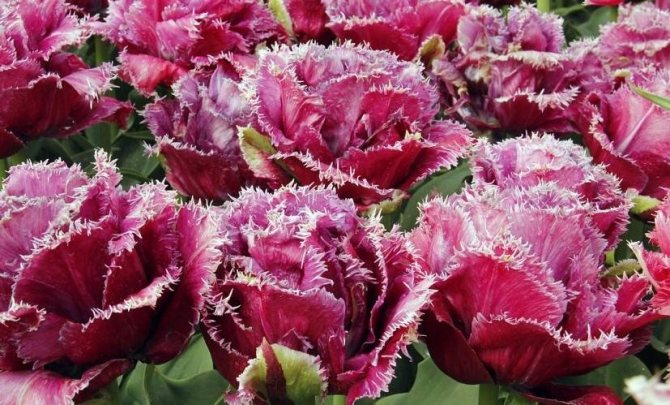

Selection of varieties for distillation
For distillation for the New Year only varieties with a cooling period of at least 16 weeks can be used, that is, early flowering. For early (by January) distillation, varieties such as Brilliant Star, Dixis Favorite, Christmas Marvel, Most Miles, Lustigue Battle, Olga, Epricot Beauty and others are suitable.
For forcing in medium terms (February-March) most forcing varieties are suitable, in particular, tulips from the Darwin hybrids class: Diplomat, London, Oxford, Oxfords Elite, Parade, Scarborough, Vivex, Eric Hofsier, Apeldoorn, Apeldoorns Elite and many others.
For distillation by April use the following varieties: Ad Rem, America, Apel Dorn, Apeldoorns Elite, Burgundy Lace, Vivex, Gordon Cooper, Daydream, Keys Nelis, Lin vam der Mark, London, Oxford, Oxfords Elite, Parade, Fringit Elegance, Hibernia, Eric Hofsier ...
For distillation by May 1 suitable varieties: Aristocrat, Diplomat, London, Negrita, Oxford, Parade, Temple of Beauty, Hibernia. In addition to those mentioned, many other varieties can be used for forcing.
Tulip varieties for forcing at home
When choosing a variety and buying bulbs, pay attention to the color class. At home, forcing bulbs is more reliable from class 1 varieties.
Bulbs of Dutch varieties marked "Giant" are selected for forcing tulips. They are stimulant treated, disease resistant, and have tall stems. Consider the characteristics of some of them:
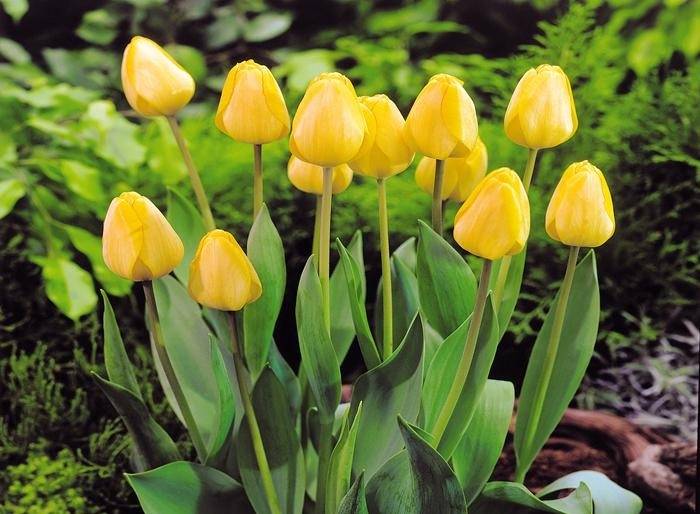

- tulip varieties Apeldoorn differ in color of petals, belong to Darwin's hybrids. Apeldoorn Elite has orange-yellow flowers with a wide yellow border; Golden Apeldoorn is a bright yellow color. The height of the stem is 45-60 cm, the diameter of the goblet flower is 6-12 cm.
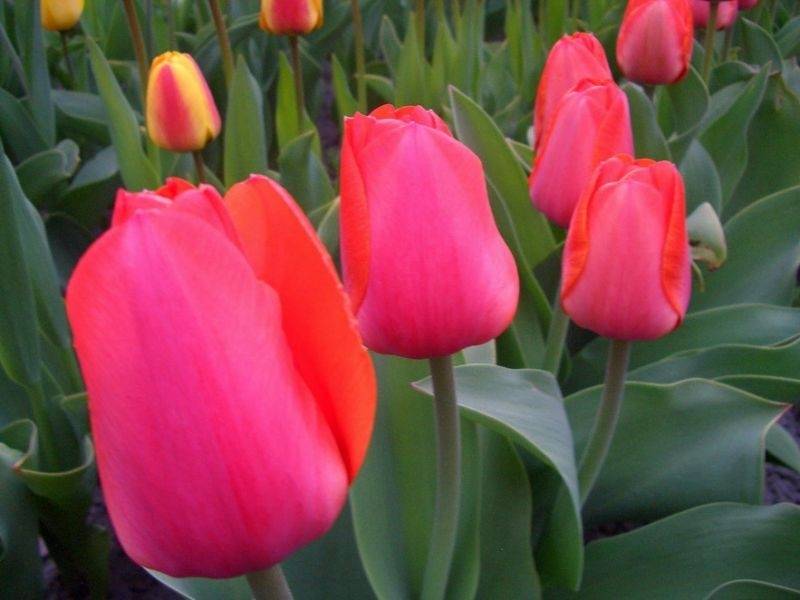

- popular variety Eric Hofsue provides high quality forcing and cutting, winner of many exhibitions. A plant with a powerful peduncle and huge goblet flowers. The color is raspberry red with a creamy white border. Stamens and anthers are yellow.
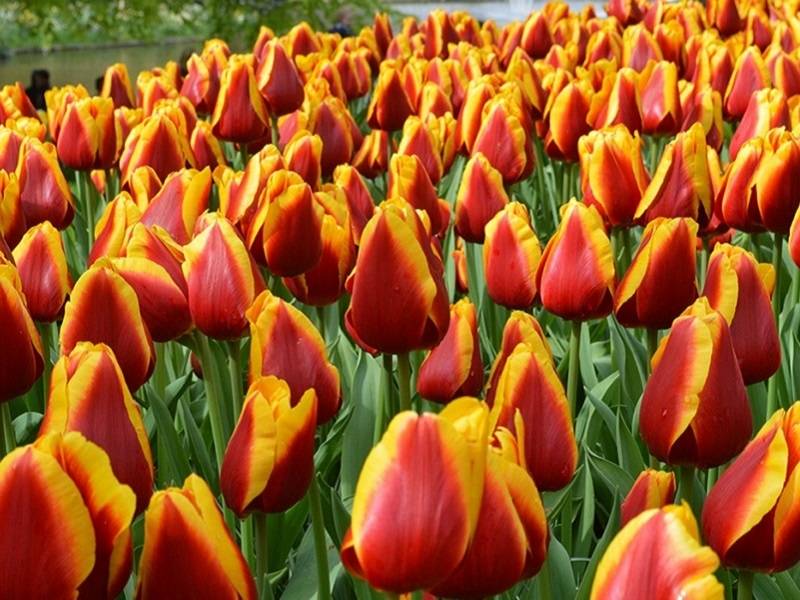

- grade Keys Nelis belongs to the Triumph group, amazes with the fragrant aroma of large (up to 15 cm) buds of pink-red, fiery orange shades. Goblet buds with incomplete opening. The subtle sweet aroma lasts 8-10 days. The stem is strong, 40–60 cm, with dark green basal leaves.
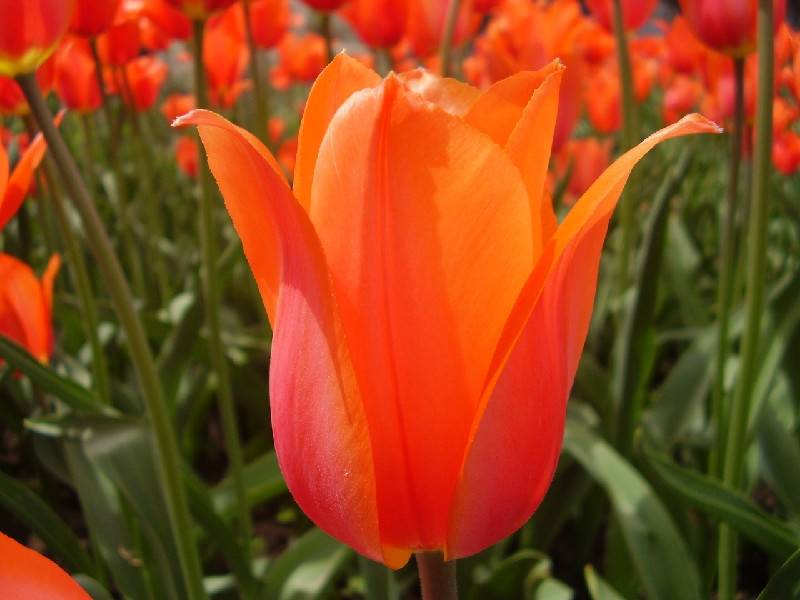

- grade Temple of Beauty in translation means "Temple of Beauty". Plant height reaches from 70 cm to 1 m. The flowers are large salmon-pink with a carrot shade, elongated lily-shaped. The buds are 14 cm. This hybrid is obtained as a result of crossing and is recognized as the largest tulip. The Temple of Beauty family includes more than a dozen varieties of sports from white to dark purple.
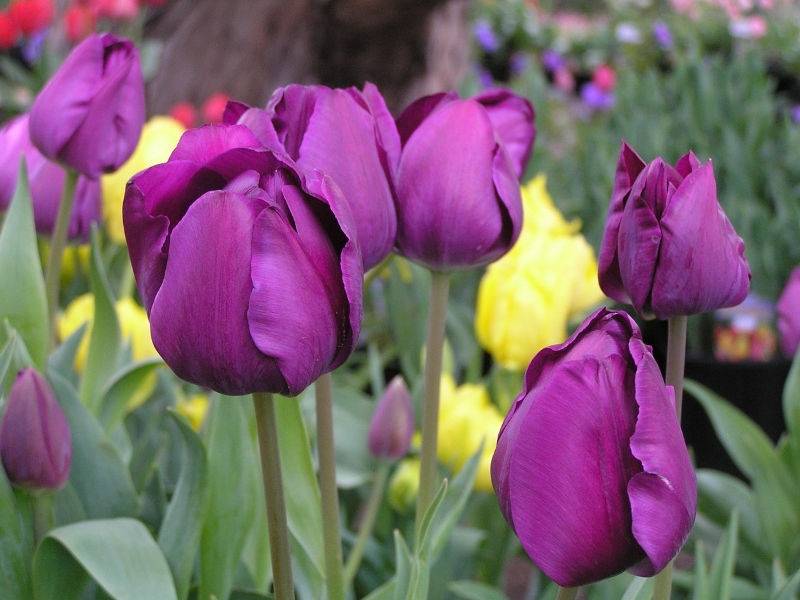

- fabulous variety Negrita with flowers of dark pink, almost purple color grows up to 50-60 cm. The stem is powerful with dense wide foliage. The buds are about 10 cm, the flowers are goblet, lily-shaped, reaching 7–12 cm in diameter.
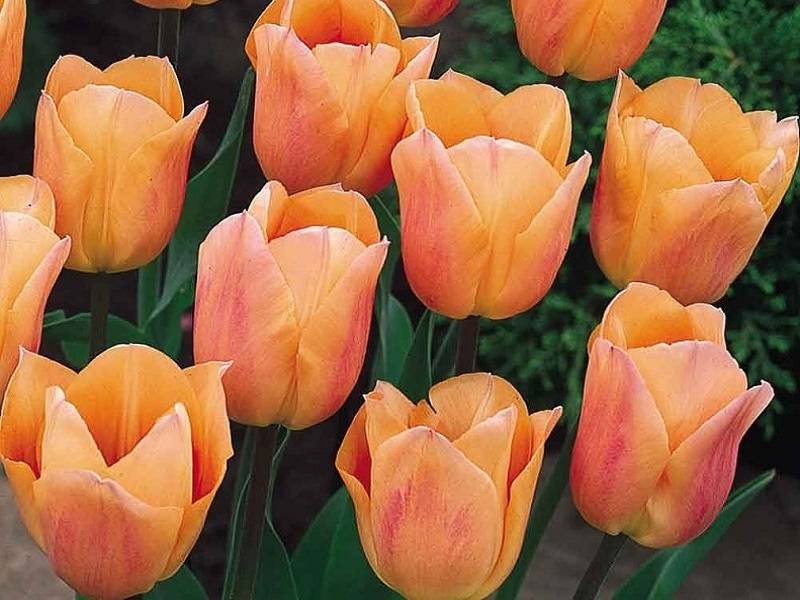

- grade Epricot beauty - fragrant apricot beauty up to 50 cm high takes first place in the top ten varieties of the English Royal Society of Florists. The color at the base of the bud (7 cm) is salmon pink with a lilac bloom, creamy white around the edges, and lemon yellow outside. The goblet buds do not fully open in the sun.
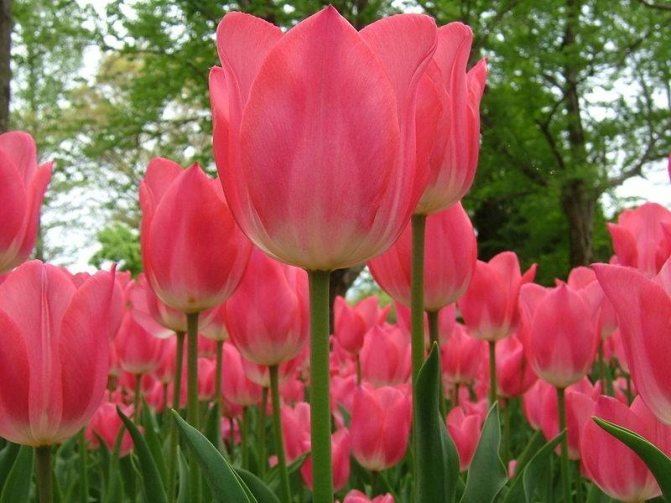

- grade Chrismas dream grows up to 25–40 cm. Peduncles are strong, flowers of warm pink tones are cup-shaped.
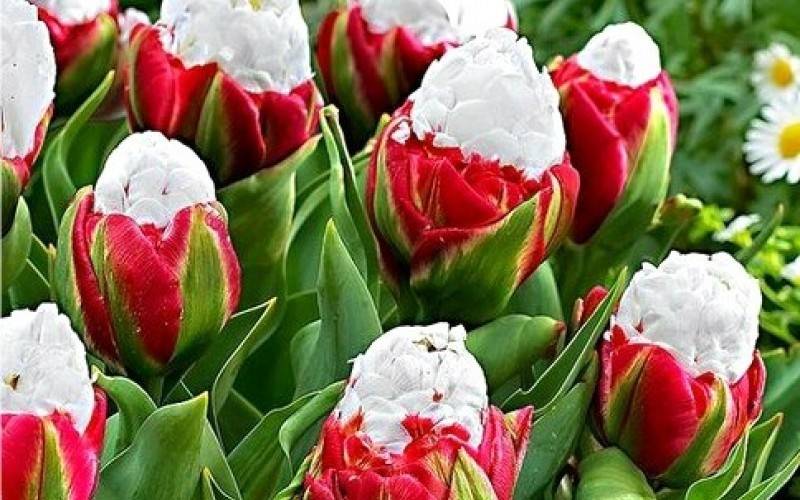

- and finally a charming tulip Ice cream - "Ice cream", pinkish petals of which frame the snow-white core. The colors are so unusual that it is impossible to resist the desire to decorate your garden with this splendor.
At home, a good bulbous planting material should be at least 3.5 cm in diameter, with strong integumentary scales, an intact bottom. Remember, you need two spare to forcing five onions.
The date of distillation depends on the tulip variety and the storage conditions of the material. Early flowering plants are recommended for early distillation and kept in the cold for 10-16 weeks.
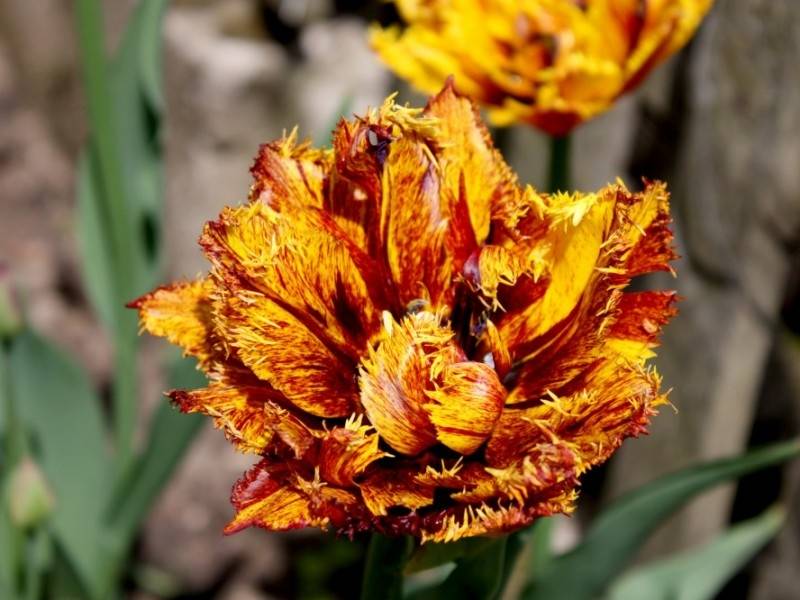

For medium and medium early forcing, Darwin hybrids are used, keeping them in the cold less than early flowers.
The material for late forcing is class 5 tulips.
There are other more unpretentious and no less beautiful bulbous. By forcing at home, bulbous irises, fragrant muscari, fragrant and multi-flowered (daffodil) daffodils will bloom together.
How to prepare bulbs for planting
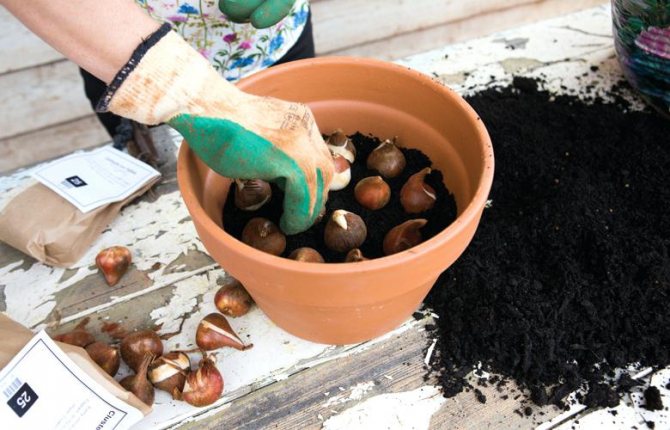

To ensure good flowering, tulips must not only be properly dried and preserved. It is required to properly prepare them, carry out a number of works to increase germination, reduce germination time, and protect against diseases. Observe these recommendations:
- Carefully examine, remove all bulbs with signs of disease and damage. If the surface is soft to the touch, also discard such corms. Leave only completely healthy and strong.
- Calibrate the planting material. For distillation in a short time, select only options with a diameter of 3.5 cm or more. The larger the better, since there are many nutrients, the sprouts will appear as soon as possible.
- Be sure to remove the kids, if any. If this is not done, then part of the nutrients will be spent on their growth, they will form shoots, as a result, the buds will grow an order of magnitude smaller. When removing, proceed carefully so as not to damage the root collar.
- Prepare a solution of saturated pink potassium permanganate, do not make it too strong. Instead of potassium permanganate, it is allowed to use Heteroauxin; for this, add half of the tablet to 2 liters of water and stir until it is completely dissolved. Place the bulbs in the disinfecting liquid, stand for 30-40 minutes, then remove, dry on paper or cloth.
If the planting material was purchased in a store and processed before planting, then it is not necessary to specially prepare it. All work has already been carried out, it remains only to plant tulips as described below. Do not soak them for a long time, do not keep them in solution for more than 40 minutes.
Preparatory work before forcing
The tulip bulbs must be prepared for forcing. In early autumn, select healthy, full-bodied specimens, dry in a ventilated room and store for a month at a temperature of 22-25 degrees Celsius.
Before forcing, remove the husk, inspect the smooth shell, revealing hidden damage and cuts. Dip the selected healthy bulbs in a solution of potassium permanganate for 30 minutes or in warm water for 5 minutes (40 degrees) for disinfection.
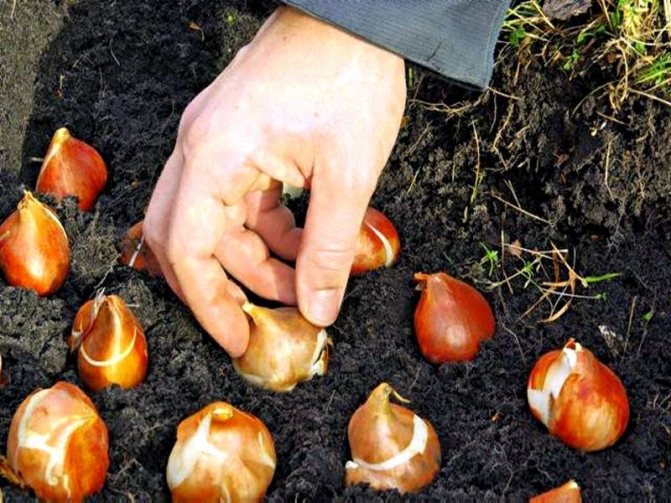

Distillation is carried out in a nutrient substrate that allows water and air to pass through (PH 6.5–7.0): in a sandy mixture of earth, sawdust and peat. Volcanic perlite is sometimes used. At home, a mixture of soil, manure and compost (2: 1: 1) with the addition of wood ash is used. Greenhouse soil is not suitable, as it contains fungal spores and harmful microorganisms. For distillation, even sawdust and peat should be pre-treated with lime mortar.
Tulip cooling period
Containers with planted bulbs are placed in a room (basement or refrigerator) with a stable temperature of + 9 ° C and an air humidity of 60-70% for rooting. For different varieties, the rooting period can be from 13-14 to 20 weeks. During cold storage, plantings are periodically reviewed and watered. In the event of temperature fluctuations, you can contain growth by covering the plantings with snow instead of watering.
To be placed in a household refrigerator, pots with tulips are pre-packed in a plastic bag.
Forcing mode
So the soil is prepared. In planting containers, at the bottom of which there are drainage holes, we plant the onions every 5–10 mm and slightly deepen them. Then we spill the plantings with a solution of calcium nitrate (20 g of fertilizer per bucket of water), and place the containers in a cold room (with a temperature just below 10 degrees) for 22 weeks. By wrapping the bulbs in heavy paper, they can also be stored in the vegetable section of the refrigerator.
Temperature conditions during the forcing stage are critical. By lowering or increasing the temperature, you can control the timing of tulip blooming.
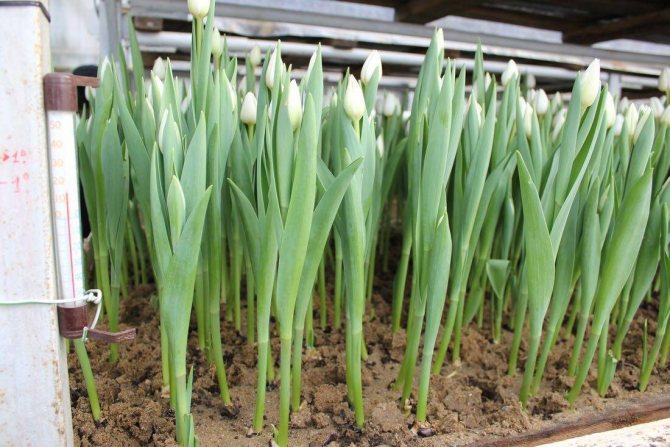

Until mid-December, sprouted bulbs need regular watering and humidity of at least 80%. Water the sprouts at the root, without affecting the leaves, stem. In the second half of the month, the temperature should be reduced by 2-4 degrees. In a heated room, with a temperature of up to +15 degrees, containers can be transferred only 1.5 months before the beginning of flowering.
To prevent the stems from stretching, they turn on fluorescent lamps indoors for 5-6 hours a day. Low sprouts are periodically covered with cardboard boxes, creating a comfortable climate. After a few days, the temperature is increased to 18 degrees. By the time the containers are moved into the room, the sprouts should be 5–7 cm high. Watering and feeding the plants with calcium nitrate should be continued, as this has a beneficial effect on the decorative effect of the flowers.
Storing bulbs for forcing
Temperature is of paramount importance at the first stage of forcing (during storage of the bulbs). By changing the temperature in one direction or another, you can control the development of tulips and, to some extent, the timing of their flowering.
The temperature effect on bulbs during storage consists of two stages:
- first - exposure to high temperatures,
- the second - reduced.
The storage regime for bulbs to be forced is slightly different from the storage regime for bulbs that will be planted in open ground. The storage regime is significantly different only for those bulbs that are intended for early and late forcing.
After the bulbs are excavated, which is carried out at the usual time for tulips, they are stored at a temperature of 20-23 ° C for a month. This temperature is considered optimal for the formation of flower rudiments in the bulb. Then, during the month (August), the temperature is maintained at about 20 ° С, and in September it drops to 16-17 ° С.
Such storage temperatures roughly correspond to the average temperatures during these months, therefore, during storage, no special equipment is required to maintain a given mode in the storage. Minor deviations from the indicated temperatures do not have a significant effect on plants. However, with significant temperature deviations in any direction, the processes of flower primordium in the bulb are slowed down or anomalies appear in the form of "blind" buds.
Complexity distillation for the New Year lies in the fact that by the time the bulbs begin to cool, all parts of the future flower should be fully formed in them. In the middle lane, the rudiments of a flower are fully formed by mid-August, and with a cool and rainy summer, this period may be postponed by another month. To speed up the laying of all organs of the flower and start cooling the bulbs at the scheduled time, there are two ways: agrotechnical and physicochemical.
Agrotechnical method consists in the fact that tulips are grown under a film and decapitation of flowers is carried out. This method allows you to speed up the process of laying all the organs of the future flower by 2-3 weeks.
Second way consists in the early digging of the bulbs. The bulbs are dug up as soon as yellowish spots appear on their covering scales. Then the bulbs are kept at a temperature of +34 ° C for a week. This temperature also helps to speed up the process of laying the organs of the future flower in the bulb. The bulbs prepared in this way are stored from mid-August until planting in the lower section of a regular home refrigerator.
The purpose of this preparation is to retard the development of the buds of leaves in the bulb and thereby enable the buds of flower organs to form faster in it.
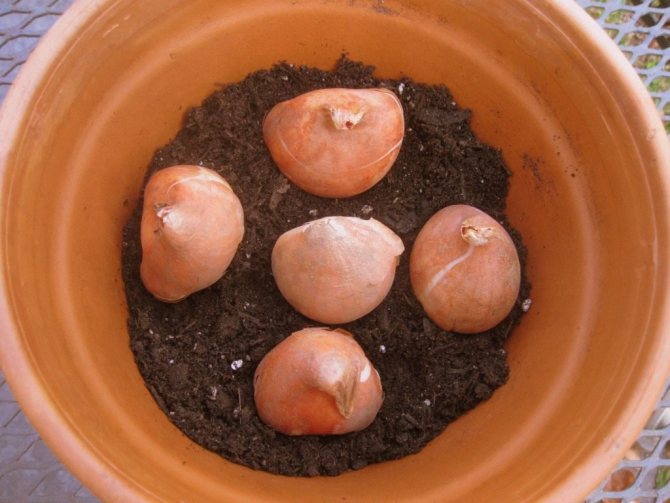

Planting tulip bulbs for distillation.
Caring for tulips after cutting
After early distillation, the plant will no longer be able to form a full-fledged baby. Therefore, you should not make an effort to grow tulips. The exception is undersized varieties. The leaves and flowers are cut, and the bulb itself is dug out after three weeks to get an average size.
After the final forcing on tulips, leave the foliage, cut the flowers. Water the remaining stems for 21 days, then dig up the bulbous crops. This method of keeping allows some plants to re-create a viable baby. Drying is carried out for 14 days at 24 degrees, 30 days at 15–20 degrees, then at 15 degrees - until landing.


The bulbs do not germinate, do not deteriorate and are well preserved when stored properly. Tulips are planted in the soil at the usual time. Only 30% of the bulbs come from the March varieties. Small children from early varieties will be able to bloom only after 3-4 years.
Forcing tulip bulbs is available even to inexperienced gardeners. The main thing is to observe the technology of storage, maintenance of temperature, humidity and lighting. Having planted plantings on time, you will receive bright buds of winter tulips in winter.
Distillation technology
We choose the bulbs that are dense, large and healthy. Before planting, we remove the covering scales from them, this will facilitate and accelerate rooting. We plant from early September to early November. The planting container must be at least 15 cm, always with a drainage hole.
First, fill in a drainage layer of 1-2 cm (crushed stone, gravel, pebbles). Then we fill the container with sand, perlite, soil mixture by 2/3. We lightly compact the surface with our palms, put the bulbs on it (without pressing!) And fill them in such a way that after watering, the tops of 1-1.5 cm are visible above the surface.Tulip bulbs are poor in calcium, therefore, from the moment of planting until the buds appear, they are watered with a 0.2% solution of calcium nitrate. The temperature of the irrigation solution should not be lower than the air temperature, and even better if it is 1-2 ° C higher.
We take the container with the planted and watered bulbs to a completely dark room with a temperature of + 5 ... + 9 ° C and an air humidity of about 75%. This is what we have organized for our bulbs "winter". It will last 11-19 weeks (depending on the variety). By varying the timing of planting, you can achieve flowering by a certain day. Of course, the first time you hit accurately on the appointed day may not work, but everything comes with experience.
After the end of the conditional "winter" period, we bring the containers into a bright, warm room (+ 12 ... + 14 ° С) for a week - this is where the "spring" begins. By this time, the bulbs should already take root and sprout 5-10 cm. Until the bud appears from the base of the leaves, the plants are sheltered from light. After 7 days, we increase the temperature, but not more than up to + 18 ° C. The expelled plants need fresh air, but the draft is destructive for them, remember this. In 3-4 weeks after the arrival of "spring" tulips will bloom!
Planting and rooting bulbs
The substrate for planting the bulbs can be any moisture-absorbing and breathable material with a neutral reaction. It can be pure river sand (Dutch flower growers use it), a mixture of sand and peat, pure peat, vermiculite, perlite, or a mixture of sand with garden soil. Even sawdust can be used as a substrate for forcing, but they do not retain moisture well, so frequent watering will be required during the rooting period.
In addition, the substrate for forcing must have a neutral reaction (pH 6.5-7), so sawdust and peat must be lime. It is also not advisable to use garden soil in its pure form, without any baking powder, since it becomes very compacted during watering.
The substrate of the following composition is optimal for forcing: 2 parts of garden soil, 1 part of well-rotted manure or compost and 1 part of river sand. It is useful to add wood ash to this mixture. It is better not to use the land from greenhouses, greenhouses, as well as poorly rotted manure - this is a favorable environment for the development of pathogens.
The prepared substrate is poured 2/3 into containers (pots, boxes, bowls) and slightly compacted. The bulbs are laid out on the soil surface at a distance of 0.5-1 cm from each other, while slightly pressing their bottoms into the soil. Then the bulbs are covered to the very top with prepared substrate or clean sand to the edges of the container. It is important that a homogeneous planting material is planted in one container - to ensure its simultaneous flowering.
After planting, the bulbs are watered abundantly. It is advisable to pour them with a solution of 0.2% calcium nitrate (20 g per 10 l of water). If, after watering, the tops of the bulbs are exposed and the soil has settled, the substrate must be filled up. It is important that there is a small layer of soil above the bulbs, otherwise bulbs may bulge out of the ground during rooting.
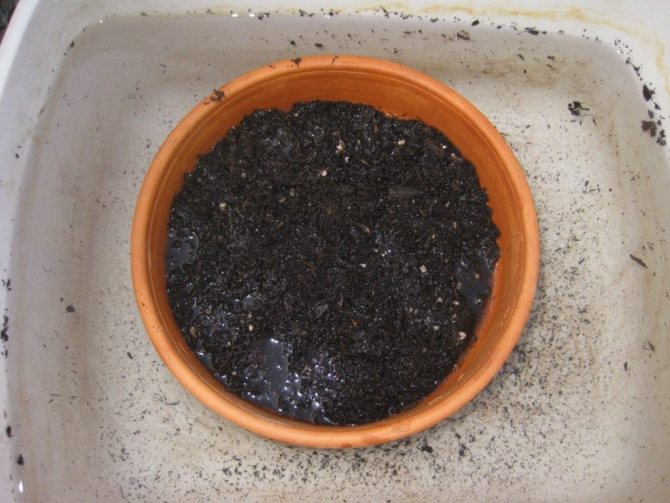

We moisten well the soil with tulip bulbs.
After that, containers with bulbs are transferred to a basement, cellar or other room with a temperature of 0 to 10 ° C (the optimum temperature is 5-9 ° C).
Until mid-December, the bulbs need to be watered weekly and the room humidity should be kept at least 75-80%. Rooting and germination of tulips, depending on the variety, lasts from 16 to 22 weeks. By the end of December, the temperature in the room where the bulbs are stored is lowered to + 2..4 ° C and maintained. Lowering the temperature this way will prevent tulips from pulling out sprouts.
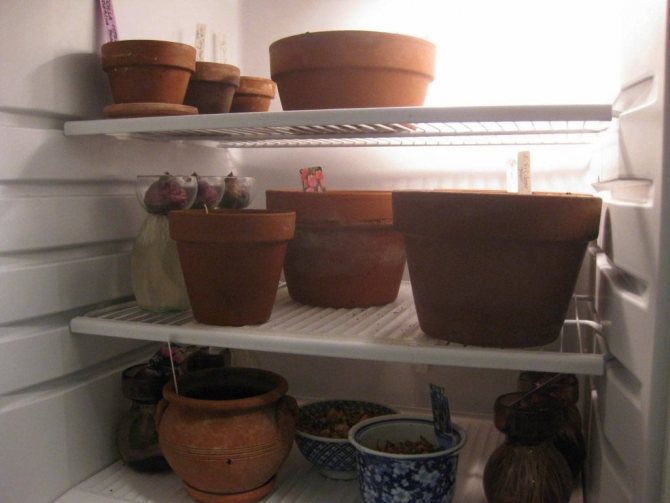

Containers with onions for distillation in the refrigerator.
How to grow tulips for the New Year
In late summer and early autumn, bulbs appear in flower shops, specially designed for winter forcing.As a rule, these are undersized tulip hybrids. In September, these bulbs are planted in prepared flat pots with soil, and the tops of the bulbs should not be covered with earth. You can choose any soil mixture. Maybe sod with sand, perlite or clean sand. It is convenient to use ready-made soil mixture for seedlings with the addition of sawdust.
The main thing is that the soil has good water permeability and neutral PH. The containers are filled with soil by two-thirds and the bulbs are laid out in it, sprinkled on top and after watering they must be stored in a cool room.
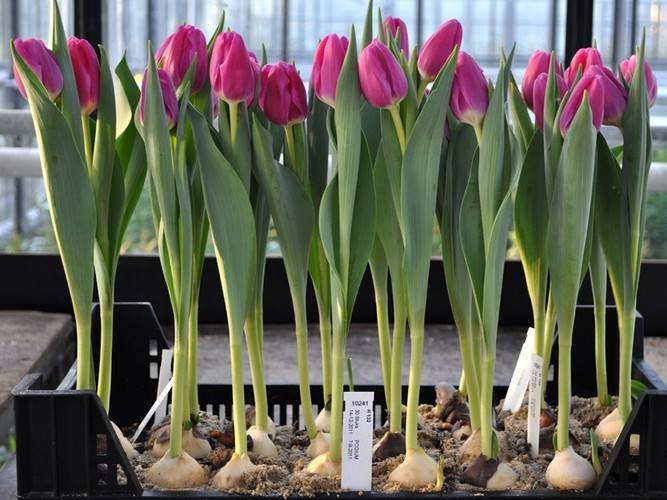

Further, tulips need to provide a dormant period in the dark at a temperature of about 5 ° C. It is better for this time to take out the container with flowers on the glazed balcony and cover them with a dark bag. The dormant period should be 6 to 10 weeks until the shoots appear. Successful rooting of tulips occurs only at low temperatures. When the sprouts reach a height of 3-5 cm, the container with flowers must be transferred to a lighter place, but at the same time it is impossible to immediately bring it into a warm room, until the buds appear, the tulips must be kept in a cool place (about 10 ° C-12 ° C) and only after their formation, you can transfer the flowers to a permanent place, where they will delight you.
The tulips can then be brought into the room or greenhouse. For the above varieties and planting dates, this will happen around December 7th. The first 2 days tulips are kept at a temperature of +15 degrees, you can put them on the window.
Within two weeks, you need to gradually accustom the plants to light, raise the air temperature to room temperature and water with water at room temperature. In ode for watering, it is better to use thawed or settled. Plants need to be fed with fertilizers containing calcium about once a week. If you follow all these rules, then forcing tulips at home for the New Year will be successful and you will receive a spring bouquet of delicate and beautiful flowers. Then you need to provide a temperature of 18-20 degrees and sufficient illumination, for which the plants are illuminated with lamps installed at a height of 0.5 m from the pots. Flowering begins in 3 weeks. To prevent tulips from stretching excessively in poor winter light, we illuminate them daily for 3-4 hours. With the beginning of the coloring of the buds, reduce the temperature by 3-4 degrees to prolong flowering.
See, it's very simple. Try it yourself and you will surprise your loved ones on New Year's Eve with a luxurious bouquet of fresh flowers.
How to store cut tulips before selling to prevent them from opening?
The preservation of the presentation of tulips is one of the most difficult tasks for gardeners on the eve of International Women's Day. In order to preserve the integrity of the flowers and keep the buds not completely open, there are several ways:
- Make an oblique cut of the stems of the plants, and a small vertical cut at the bottom
- Remove excess foliage
- In the prepared storage liquid, dilute a few potassium permanganate granules
- Drain and refill the flowers with new ones daily. However, remember to use only cold liquid.
- Also renew the stems regularly by pruning festering parts to avoid infestation of other tulips.
- It is important to store containers with plants in a bright place, however, excluding exposure to ultraviolet rays
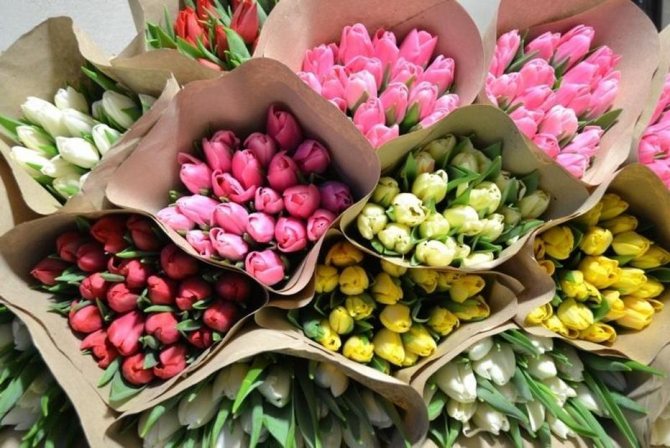

Storing cut tulips
Also, the following drugs can be added to water without potassium permanganate:
- Small amount of coal
- 3% sugar solution
- Specialized garden additives ("Flora" or "Bud")
- 1 capsule of acetylsalicylic acid
- Acetic solution (1 tablespoon for 1 liter of liquid)
The following supplements are no less useful:
- Branch of any coniferous plant
- Ice cubes
- Snow
Cold liquid and a room temperature of no higher than + 2 ° C will help prolong the life of flowers by stopping the process of premature opening of buds from 7 to 14 days, but in this case it is necessary to abandon lighting, since artificial and ultraviolet rays can accelerate the flowering process of tulips.
How to grow tulips for the New Year in water
Start by purchasing large tulip bulbs suitable for planting and forcing at home. Pink Impression, Monte Carlo, Ad Rem, Princess Victoria - there are many varieties, choose any color you like.
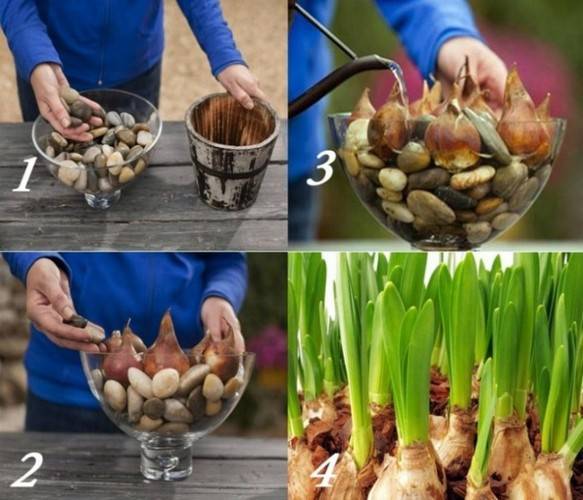

Place purchased bulbs in the refrigerator for 13-17 weeks.Important! In no case should apples be stored next to the bulbs, otherwise the plant may not bloom.
Pour stones and beads into a vase, fill it with water almost completely.
Place the tulip bulbs on top of the pebbles, sprouts up. The sprouts of the bulbs must get to the water themselves; the bulb should not be dipped in water, otherwise it may simply rot.
Place the vases of bulbs in a cool, dark place for about 6 weeks.
Finally, transfer the vases with the cherished tulips to the sunny windowsill! After 3 weeks, they will delight you with unprecedented beauty with flowering.
Fresh articles about garden and vegetable garden
Cutting flowers into bouquets and keeping them
Tulips are cut for bouquets at the base, with all the leaves, when the buds have not yet fully blossomed. Best in the morning, before watering, and immediately placed in a cool environment. If the bulbs are no longer to be used, they can be pulled out with them and cleaned of scales - this will allow the stems to lengthen.
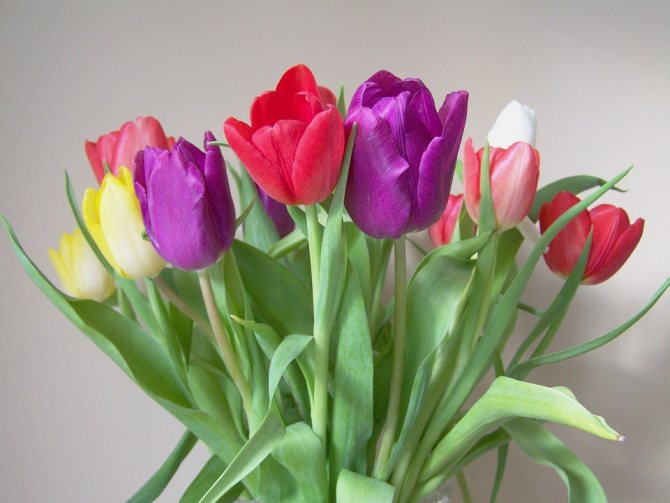

There are two ways to store cut tulips:
- Dry. Wrapped in paper (up to 50 pieces), stored in the refrigerator for up to 2 weeks. Before making bouquets, they are placed in water, updating the sections of the stems.
- In water. Store for a day. If with snow, store in a dark room for about 15-17 days.
Planting tulips for distillation
Tanks for planting are needed with drainage holes covered with some kind of shard. Drainage is poured on top. Two-thirds of the soil is poured into prepared pots, containers, boxes, and compacted.
Tulips are planted two centimeters apart, gently pressing them into the soil two to three centimeters deep. Top up with the remaining soil. Water the plantings, if the tops of the bulbs are visible from the ground, they are also sprinkled with soil. For irrigation, a gram of calcium nitrate is diluted in a liter of water and spilled with this planting solution.
Decrease in temperature
The planted tulips are removed in a room without light with a temperature of 7 - 9 degrees and kept for 16 weeks. When sprouts appear, the temperature is lowered to 5 degrees. The planting film must not be covered. Such cooling is favorable for the rooting of the bulbs, they accumulate substances that are responsible for the growth of the future peduncle.
Watered as the soil dries up and kept in a cool place without lighting.
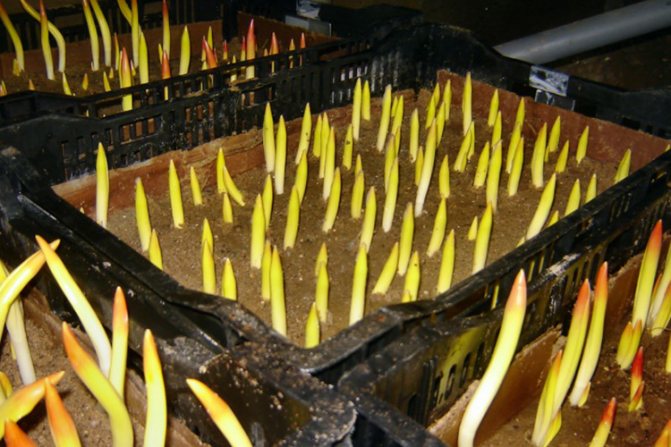

Raise the temperature
Sprouts will start to appear in January. When they reach five centimeters in height, the boxes are taken to a sunny and warm room. The temperature is gradually increased.
Lighting is important for growing tulips. If there is a shortage, the peduncles will stretch out, the buds will become smaller, or the effect of "blind" buds will appear. Therefore, plants need light for at least 10 hours a day. If there is not enough sunlight, use a backlight. The required amount of time.
It so happens that the flowering of buds occurs earlier than planned. Then the tulip with the bulb is wrapped in paper and placed in the refrigerator.
With the help of temperature, it is easy to regulate the required periods of forcing of plants. To speed up the forcing process, the room temperature is increased; if the forcing is ahead of schedule, the temperature is lowered and the process slows down. In order for flower stems to grow strong, and of normal length, they regulate the light.
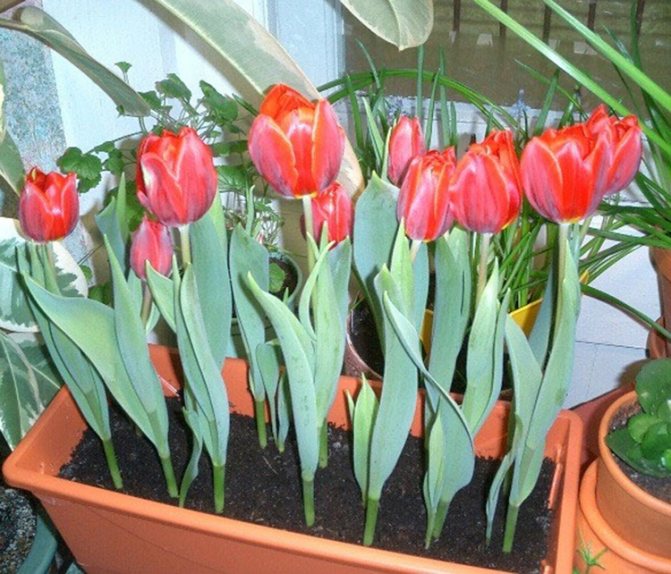

Forcing tulips is done at home on the windowsill, as well as in the greenhouse. The greenhouse follows the rules.
- Tulip buds are deformed from excessive heat.
- The stem will not grow long enough if the cooling period is too short.
- When the leaves begin to grow, remove the plant from the strong sun color. Otherwise, the energy of the plant will go into the growth of green leaves, and it will not have enough strength to form buds.
- In strong sun, the bud opens ahead of schedule.
- Calcium nitrate is watered only at the beginning, then it is no longer necessary.
- The number and quality of buds is influenced by feeding and watering.
- Do not store flower bulbs in the refrigerator with fruits that release ethylene.
- If the temperature rises during cooling, the quality of future flowers may decrease. After all, the formation of a flower bud occurs during the cooling period and directly depends on the temperature regime.
- Long-term cooling is also harmful, as deformation of the buds will occur.
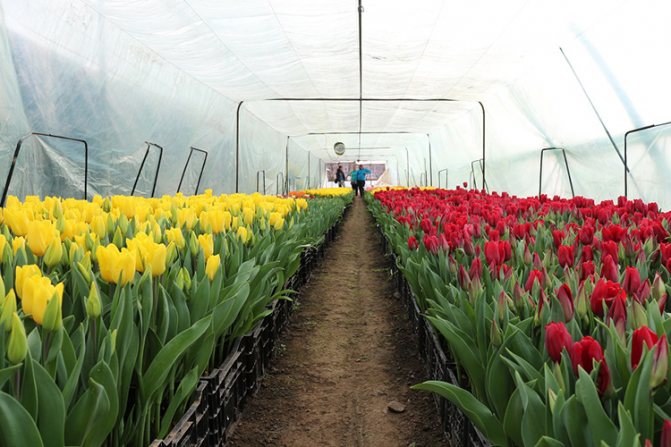

Watering and feeding
Tulips are watered every morning, being careful not to fall on the leaves. Water is needed cold, 12 degrees, preferably thawed, since there are no harmful impurities. In the first ten days, it is watered every other day with a solution of calcium nitrate. This procedure will help the formation of strong peduncles. When forcing tulips, fertilizing is done with fertilizers designed specifically for bulbous plants. But remember that excess fertilizer causes leaf burns, affects the quality of tulips, and leads to a delay in flowering. Top dressing is optional, since the tulip takes all the nutrients from the bulb.
In order to be able to admire the bright colors as long as possible, they should not be kept in direct sunlight and the room temperature must be lowered to +15. Then the flower stalks will be stronger, and the color of the flower buds will be more intense.
Plants begin to bloom after three weeks and continue for up to 10 days. If, during the period when the buds are stained, the temperature is lowered to 10 - 12 degrees, then flowering can last up to 14 days.
How to chase tulips: basic ways
There are two main methods of forcing. The so-called classic, when the bulbs are cooled at a temperature of +9 ° C and a method that has become widespread in Holland, and recently in other countries, when the bulbs are cooled at a temperature of +5 ° C.
When forcing tulips using a 5-degree technology, the temperature is maintained with an accuracy of 0.5 ° C, which is easily achieved in large flower farms with the necessary equipment.
Among amateurs, the most common is the 9-degree distillation method. With this method, tulips can be planted in boxes, pots or directly into the ground. The bulbs are planted in early October.
The planting density is 2.5-3 times higher than with conventional tulip cultivation in soil, i.e. 250-300 bulbs per m2. With the onset of frost, the ridges are mulched with peat. From the middle of January, a plastic film is stretched over the previously prepared frame, and the greenhouse begins to be heated.
The snow is not removed and it melts as the temperature rises. Melt water is a good stimulant for tulip growth.
A notable feature of this method is the freezing of bulbs at temperatures close to zero or even below 0 ° C, and such freezing not only does not negatively affect the forcing process, but, on the contrary, has a beneficial effect and tulips bloom in unison.
For all its simplicity, this method can hardly be considered rational, since it requires a lot of heat. It is acceptable in regions with mild climates.
For an amateur florist, of course, the method of forcing in boxes is more accessible and acceptable, since in this case it is easier to choose a room for rooting and for subsequent forcing. For rooting, you can use a basement, cellar or some other room.
You can drive out in a room, a warm shed, a warmed attic or garage, and even in a cellar under artificial lighting. With sufficient illumination and duration, the saturation of the color of the flower does not decrease, and in the Eric Hofsyu variety it even increases.
What to do with tulips after cutting
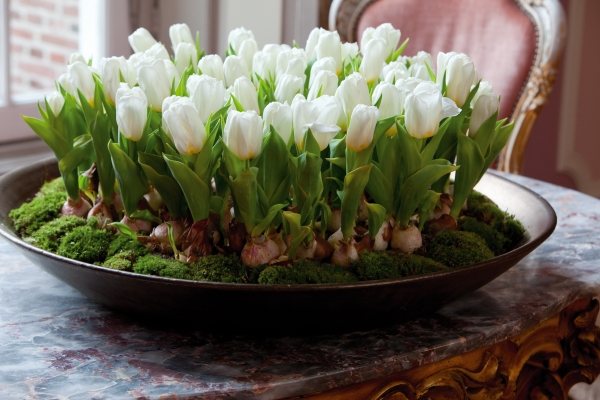

After cutting the flowers, watering the soil and the remaining bulbs is carried out 2 times. All this time, the soil must be moist. Leaves should not be allowed to wilt completely. Then they do the following:
- The planting material is dug up and dried for 3-4 days.
- Inspect for damage.
- They are taken to a room where the bulbs will be stored until they are planted in the soil. They are suitable for another distillation.
Why tulips don't bloom
There are several reasons:
- low quality planting material;
- bulbs from their garden are improperly prepared for distillation;
- violation of the terms of rest (low temperatures) and active growth (increase in temperature, increase in daylight hours);
- decay of planting material in the absence of treatment of bulbs and soil with disinfectants;
- the florist dug out the basis for bulbous plants at the wrong time;
- planting material was stored at too high or low temperatures.
Tulip varieties for a New Year's or Christmas bouquet
From the group Simple early:
- Princess Irene - orange flower with purple stripes,
- Ruby Red - bright scarlet
- Flyer - bright red with yellow border,
- Yokohama is yellow.
Terry early ones are also suitable for forcing, such as yellow Monte Carlo, pink Peach Blossom and Stockholm, Abba and Electra reds, fringed red and gold Fringet Beauty.
Since tulips from this group are low (25-35 cm), it is better to drive them out not for a bouquet, but for interior decoration.
From the group Lily-colored:
- white White Trimfator, yellow West Point,
- bright red Red Shain,
- red with white border Aladdin,
- lilac with white border Ballad, pink Marietta, dark pink Jacqueline.
The plants in this group are 50-60 cm tall and are ideal for festive bouquets.
Varieties of the Kaufman group low, for distillation in pots and use in arrangement are recommended:
- Orange Boy (orange with a carmine-red back),
- Stresa (yellow with an orange-red back),
- Speranza (bright red).
- The peduncles of these plants are 15-25 cm, while the Speranza variety has only 10 cm.
Growing problems
Sluggish leaves must be removed, and it is better to cut off the yellowed plant completely, this will save the bulb from decay.
If yellow spots are visible on the leaves, nematodes may appear. In this case, diseased bulbs must be dug up and destroyed before they infect neighboring plants.
Tulip bulbs can become infected with gray mold or fungal infections. It is important not to plant planting material with a hint of the presence of fungus.
Pots with bulbs, if they are outside, should be brought into the heat with the first frost. For the winter, the bulbs need to be dug up and stored in the cold. Replace the ground when it is time for the next landing.
Preparing the bulbs
Tulip bulbs must go through a stratification procedure to be successfully forced. There are two ways, which we will discuss below.
If you bought already prepared chilled onions, then after planting in pots and rooting, they do not need to be in the refrigerator or basement - they are immediately put into room conditions.
Option number 1. Long-term cooling 100-130 days
To receive flowers by the required date, you can calculate the required period in advance. How to carry out this stratification:
- Bulbs are sent to a basement or other room with a temperature of about +9 degrees. There should be no sharp fluctuations.
- Indoor humidity is about 75-80%. In this case, it is impossible for condensation to accumulate on the bulbs.
Option number 2. Short cooling
For this, a special refrigerating chamber is used. The temperature in it should be about +5 degrees. The stratification period is 45 days.
Without the influence of the cold, the growth and development of the aerial part and the appearance of buds cannot be achieved.
Forcing soil
Despite the undemanding composition of the soil, flower growers recommend cultivating tulips at home, using good black soil or a special loose light mixture from a store or prepared yourself.
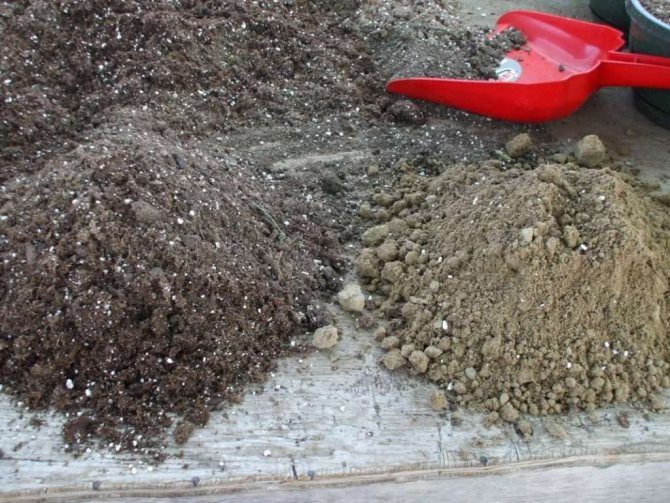

To prepare mixture No. 1 you will need:
- 1 part of clay soil;
- 2 parts of peat;
- 2 parts of coarse river sand or vermiculite.
To prepare mixture No. 2, you will need earth: leaf and vegetable garden, humus and peat, coarse-grained river sand or vermiculite - 1 part by weight. The acidity of the soil should be neutral or slightly alkaline.
reference... Unlike garden or garden soil, store-bought potting soil is more nutritious for plant growth, it allows moisture to pass through well and does not dry longer.
Technology
For novice growers, tulip distillation technology can seem like a daunting task. In fact, everything is much simpler if you break the whole process into main stages:
- Cleaning and storage of bulbous culture.
- Planting the bulbs in a substrate for rooting and germination.
- Forcing plants directly.
Prepare tulip bulbs for subsequent distillation in the summer, when growing flowers on the site. Select the healthiest, strongest plants and care for them carefully throughout the growth period. After harvesting, store the bulb culture at 25 ° C for 30 days. In August and September, lower the storage temperature by 3 and 5 ° C.
When planting, tulip bulbs are placed in a nutrient medium with a neutral medium. The planting date depends on the planned timing of the appearance of the buds. The planting material is planted in pots with a step of 5-10 mm, a little buried in the soil and watered. Then the container is transferred to a cold room with a temperature below 9 ° C for 16 ... 22 weeks.
In the third stage, the sprouted bulbs are transferred to a warm room and provided with the proper temperature regime. In order for the plant not to receive stress, the temperature should be within 12 ... 15 ° С. Provide dim lighting for seedlings. The sooner flowering is expected, the sooner they should be transferred to warmth. By the time the containers are moved into the room, the size of the sprouts should be 5-7 cm.
Landing dates
Bulbs are planted at different times: the period depends on the date by which it is important to get delicate tulips. Cultivation of spectacular flowers takes about 4.5 months, you need to be guided by this indicator.
Popular holidays and planting periods:
- February 14 (Valentine's Day, Valentine's Day). Early October.
- February 23 (Men's holiday, Defenders of the Fatherland Day). October 10-12.
- March 8 (Spring Festival, International Women's Day). October 15-20.
The best option is hardening and rooting of the planting material in a cool room, then moving to a windowsill, a heated veranda or into a room. This method, subject to the rules of cultivation, gives a good result.
When and how to cut the buds
The best terms are selected taking into account the duration of storage of flowers:
- for the holiday (keep from three to four days). The buds should have a specific varietal color without a green tint;
- for sale (storage for one to two weeks). Tulips are cut when the color characteristic of this variety begins to appear on the buds, and the top is still light green.
Cut flowers are wrapped in paper or newspaper, taken to a cellar or basement: storage is carried out only at low temperatures.
It is useful to water the flowers with water before and after cutting them for sale or making a bouquet for a gift. First, the bottom of the stem is cut, then the specimens are placed in a container with cold water, moved for 24 hours to a cool veranda or to another cool area.
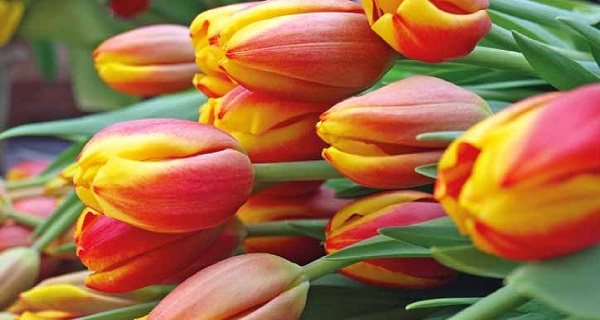

Soil composition for forcing tulips using 5- and 9-degree technology
Before you kick out the tulips, you need to prepare the right soil. Pure river sand, peat, sawdust, earth, perlite can be used as a substrate, but each of them has its own disadvantages.
Sawdust does not hold water well and requires frequent watering during the rooting period and subsequent cooling. In addition, sawdust, like peat, must be lime. The land from the site is compacted during irrigation.
The most optimal is the following soil composition for forcing tulips: 2 parts turf or garden soil + 1 part river sand + 1 part completely decomposed manure or compost. The substrate is mixed and wood ash is added to it at the rate of 1 cup per standard forcing box.
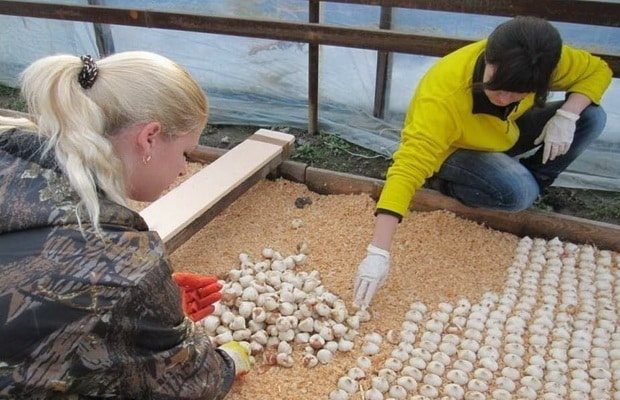

A prerequisite for any substrate for the correct distillation of tulips is its breathability and sterility. You cannot take land from greenhouses, compost heaps, from the garden, especially where tulips grew. With an infected substrate, no dressing of the bulbs will help, and a significant part of the flowers will be destroyed.
The preparation of a full-fledged substrate and the use of dressings during the forcing process undoubtedly increases the percentage of flowering plants and improves the decorative qualities of flowers. However, it should be remembered that adequate planting material is still critical to successful forcing.
Bulbs of "extra" or 1st analysis are used as planting material, weighing at least 30 g for varieties of the Darwin hybrids class and at least 25 g for varieties of other classes.
It is possible to use bulbs of the 2nd parsing only of certain varieties, and the bulbs of the 3rd parsing are generally inappropriate to use, because the decorative qualities of flowers and the productivity of flowering are sharply reduced.
Before planting, the bulbs must be cleaned of covering scales for two reasons:
- Firstly, the roots penetrate more easily into the substrate, and the bulb takes root faster, while with dense covering scales, they begin to grow along the bulb, pushing it up, which leads to a deterioration in the decorative qualities of the flower.
- Secondly, removing scales allows you to identify subtle signs of disease. These bulbs should be pickled, after which they are planted for distillation. Planting material with strong signs of damage is discarded.
Which varieties to choose
For the procedure to be successful, you need to correctly select the varieties of flowers. Not all of them are suitable for winter cultivation. In addition, the time by which you want to get flowering plants also plays a role.
By the new year
Early flowering varieties are suitable for this, as their cooling period is only 16 weeks. Such varieties include Epricot Beauty, Christmas Marvel, Brilliant Star and others (Figure 2).


Figure 2. Varieties for cultivation for the New Year: 1 - Epricot Beauty, 2 - Christmas Marvel, 3 - Diamond Star
The same species are also suitable for growing for Christmas, as they have a sufficient flowering time to maintain buds in late December and early January.
By March 8
Cultivars that can bloom in late February or early March are Darwinian hybrids.
These plants have very diverse petal colors, and the thickness of the stems allows them to be used not only as a green decor, but also for cutting.


Figure 3. Varieties for cultivation by March 8: 1 - Oxford, 2 - Diplomat, 3 - Scarborough, 4 - Vivex
Popular varieties of this type include Oxford, Diplomat, Eric Hofsue, Scarborough, Vivex and others (Figure 3).
By April
Cultivars for cultivation by April require more maintenance. First, they are exposed to low temperatures longer. And secondly, after that they need to be properly warmed up to activate growth and flowering.


Figure 4. Varieties for cultivation by April: 1 - Ad Rem, 2 - Gordon Cooper, 3 - London, 4 - Parade
The varieties for such cultivation are also quite diverse. Among them are Ad Rem, Gordon Cooper, London, Daydream, Parade and Oxford Elite (Figure 4).
By May
Cultivation of tulips by the beginning of May is carried out mainly using late-flowering varieties. However, other types can be used if certain conditions are met.


Figure 5. Varieties of tulips for May: 1 - Aristocrat, 2 - Negrita, 3 - Hibernia
The most popular are the varieties Aristocrat, Negrita, Parade, Hibernia and others (Figure 5).
Beautiful bouquet
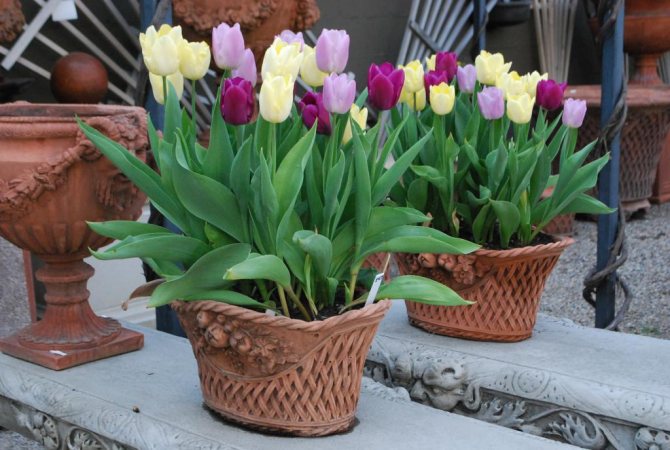

If a pot is used for planting, the bulbs are placed almost closely to each other. A bouquet is formed in advance - they take an odd number - 3, 5, 7 bulbs.
In order for the tulips to be symmetrically positioned during flowering, at the time of planting, the convex parts of the bulbs are positioned towards the center so that the first leaves are directed outward. This is also necessary so that its leaves do not interfere with the normal development of neighboring plants.
Care features
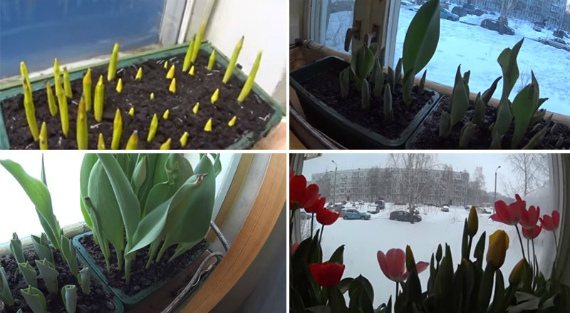

In the process of forcing, the bulbs must be monitored so that they do not dry out and freeze. Especially if the container with tulips is on a glazed loggia or balcony, where the temperature can be unstable. The earth should not completely dry out. Periodically, the condition of the soil is checked and, if necessary, slightly moistened. Inspect the bulbs at least once a week.
Waterlogging of the substrate is unacceptable, otherwise the bulbs will rot.
After the emerging sprouts reach a height of 4-5 cm, the container can be exposed to the light. This usually happens in early February.
For further distillation, a room windowsill is best suited, since it is here that the temperature required for tulips during this period is maintained at 15-18 ° C.
However, direct sunlight should not fall on the plants. If your apartment has only a southern windowsill, arrange shading with a sheet of white paper or gauze.
At the initial stage of growth, tulips can be fed with nitrogen-containing fertilizers (ammonium nitrate, urea solution according to the instructions). At the time when the buds begin to appear, potassium sulfate or calcium nitrate can be added.
There is no urgent need for fertilization if suitable soil was taken for forcing, and the bulbs themselves are large enough.
Advice
For more confidence in success, you can follow the recommendations:
- For watering, it is better to take settled water, not colder than room water.
- It is important to fertilize during the tulip growth stage.
- Protect young shoots from direct sun.
- Plant pots are best placed away from bright light, but not in full shade.
- Drafts can change temperatures abruptly, leading to plant diseases.
- The close location of the battery can prevent tulips from blooming in time.
Knowing all the rules, you can safely take on growing tulips for the holidays, because the process, although long, is quite simple. Anyone can cope with such a task with all the necessary materials.
Planting bulbs
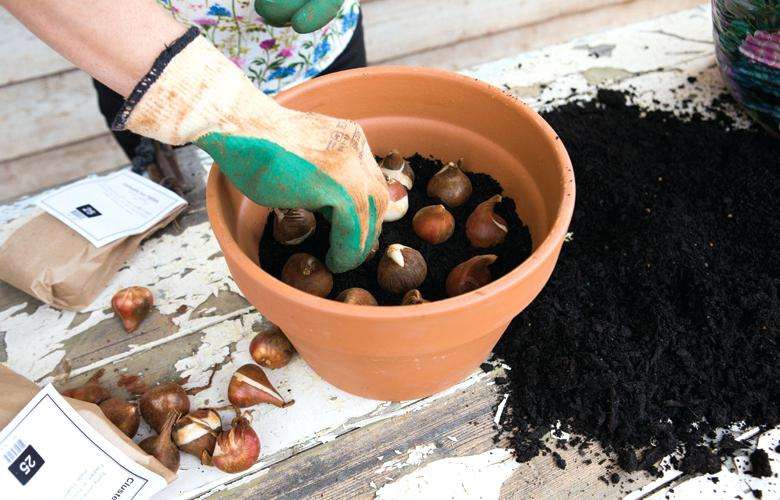

How to plant tulips at home (general instructions):
- Laying thin drainage on the bottom of the container. Material - gravel, expanded clay, ceramic fragments, small stones. Drainage is necessary for the free flow of excess water and to prevent soil leaching.
- Falling asleep
on top of the drainage of the soil mixture so that the tip of the bulb is 1 cm below the level of the edge of the container or at the level of the upper edge. With a pot or bowl height of 15 cm, and the bulbs are 5 cm, the drainage is poured with a layer of 1 cm and the soil is 9-10 cm.
- Light irrigation of the soil with weak potassium permanganate.
- Peeling the husks from the bulb and lower root parts.
- Installing and pressing the root part into the soil so that the flat sides are turned towards the wall of the container. You cannot scroll! Observe the distance between the planting material and the container wall, as indicated above.
- Fill up the planting material with soil, holding it to prevent overturning on its side and not compacting the top layer. The sharp tops remain uncovered.
- Abundant watering of future tulips and installation in a cool room for 5-7 weeks at a temperature of + 4-6 ° C and a humidity of 70-75%. At the same time, the pot with seedlings is closed with black dense cardboard in the form of a cone, making a hole in it at the top for air exchange. The cone or newspapers will protect the planting material from the light of the light bulbs in the basement or cellar.
- Moving the pot with seedlings from a cool to a warm room for 6-7 days at a temperature of 12-14 ° C: on windows where there is no central heating, near the balcony door. Do not remove the dark cardboard cone.
- Watering the seedlings when the top layer of the earth dries up.
- Removing the shading with a cone when the sprouts reach 7-10 cm in height and placing the pot in a bright place with diffused sunlight (not direct ultraviolet light!) At an air temperature of 18-21 ° C. Better on east or west windows.
- Feeding the planting material 1-2 times together with watering when the soil dries up with a solution of calcium nitrate or complex fertilizers for plants blooming in the room.
- Transfer the container with tulips overnight to a cool place near the balcony door and return to a warm place in the morning in order to increase the flowering time.
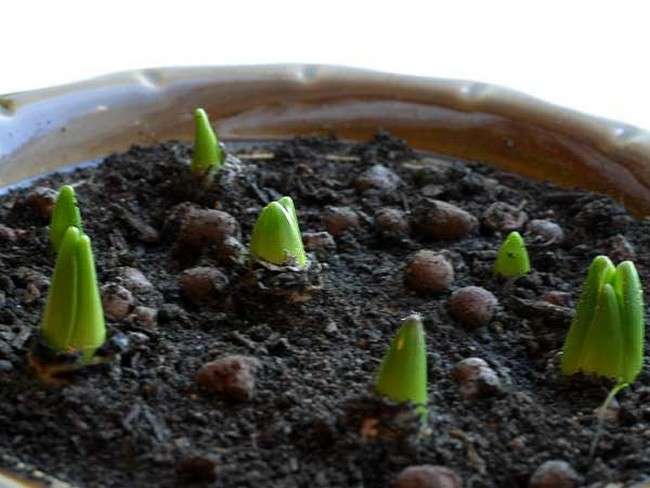

After the end of flowering in July, you should break off the buds and gradually reduce the amount of watering until the leaves turn yellow, and remove the bulbs from the ground and sort by size and variety before storage.
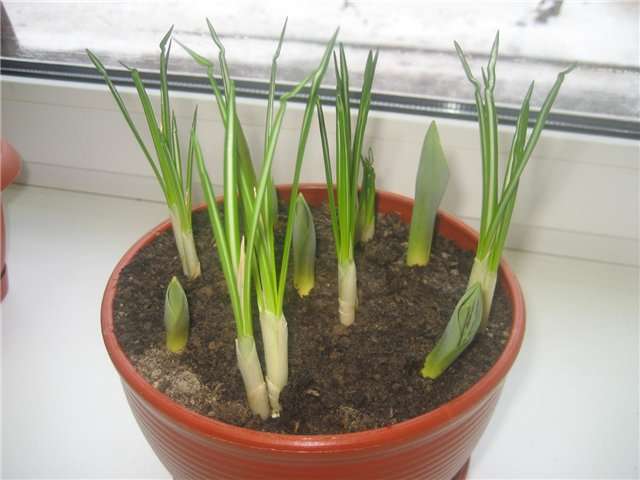

Be sure to remove damaged and diseased bulbs, since tulips on the balcony in boxes or pots indoors in the next season can only be healthy and not depleted. Weak ones can be placed in open ground, they will get stronger and bloom next spring.
Useful Tips
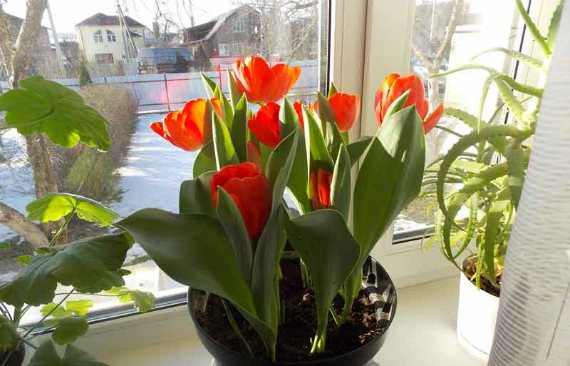

Bulbous flowers are good because they allow them to bloom at any time of the year, creating certain conditions for this. This process is called forcing. Here are some things to watch out for:
- Tulip bulbs should not only be large, but also weighty, without traces of damage. They are stored in a dry, dark place until disembarkation.
- If you do not want to cool the planting material for weeks at home, pay attention to the presence of the mark "for winter distillation" before buying. These bulbs have already passed the cooling period in production, they can be planted immediately in pots and kept at room temperature.
- You can plant tulips for distillation in ordinary clay pots, which should then be placed in exquisite pots so that the flowers become a real decoration of the interior.
- For the period while the bulbs are sprouting, the surface of the soil can be decorated by spreading moss or gravel on top.
- If you do not plan to cut, plant bulbs of the same size and variety in one container so that tulips look harmonious during flowering.
- The drain hole in the bottom of the pot should be large enough. In order for it to fully fulfill its function, it is covered with a clay shard from above.
- When planting multiple bulbs, make sure they do not touch the sides of the pot.
- Leaving tulips to bloom in a pot requires proper, regular watering. The soil should always remain slightly damp.
- For longer flowering, primroses in a pot are fertilized once a week with a solution of complex fertilizer.
- If you spend the period of cooling the bulbs yourself, it is not recommended to shorten it, otherwise you will not get high-quality flowering.
- Keep tulips in bright light until the buds begin to dissolve. After that, it is better to remove the flowers from the window, since they cannot stand the bright sun, drafts and temperature changes.
Features of an interesting process
Note to flower growers:
- the process takes more than four months;
- not all varieties are suitable for forcing;
- planting material must be of high quality, large, heavy;
- it is imperative to disinfect the bulbs and substrate to reduce the risk of fungal infections;
- the soil is nutritious, but with good aeration, loose;
- it is important to adjust the temperature at different periods so that the sprouts do not appear ahead of time;
- after forcing, you can put the bulbs in storage for further germination, if the base has not lost all the juices and is in an acceptable condition.
